Search Result
Results for "
ventricular
" in MedChemExpress (MCE) Product Catalog:
2
Biochemical Assay Reagents
10
Isotope-Labeled Compounds
| Cat. No. |
Product Name |
Target |
Research Areas |
Chemical Structure |
-
- HY-130335
-
|
MJ9067
|
Others
|
Cardiovascular Disease
|
|
Encainide (MJ9067) is an antiarrhythmic agent with class IC activity. Encainide has the potential for life-threatening ventricular arrhythmias, symptomatic ventricular arrhythmias and supraventricular arrhythmias research .
|
-
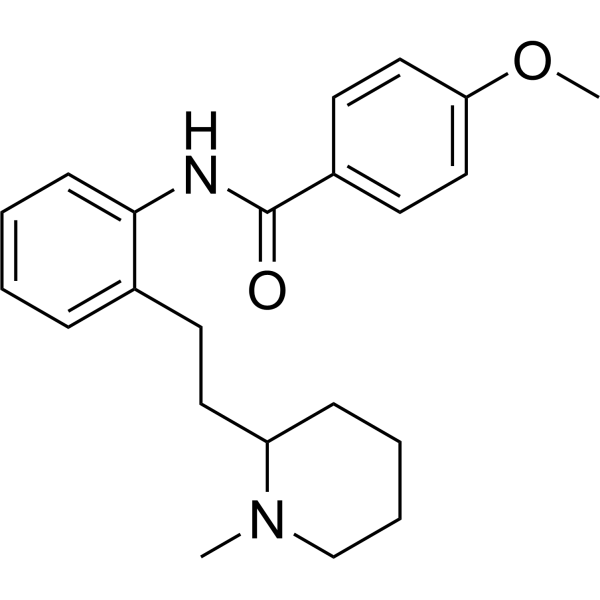
-
- HY-B0772A
-
|
MS-551
|
Potassium Channel
|
Cardiovascular Disease
|
|
Nifekalant hydrochloride (MS-551), a class III antiarrhythmic agent, is a IKr potassium channel blocker with an IC50 of 10 µM. Nifekalant hydrochloride can be used for refractory ventricular tachyarrhythmias research .
|
-
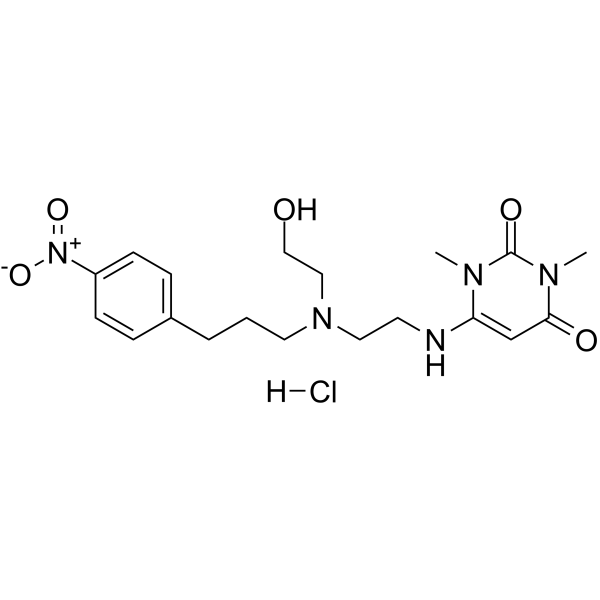
-
- HY-12531
-
|
MJ9067 hydrochloride
|
Others
|
Cardiovascular Disease
|
|
Encainide (MJ9067) hydrochloride is an antiarrhythmic agent with class IC activity. Encainide has the potential for life-threatening ventricular arrhythmias, symptomatic ventricular arrhythmias and supraventricular arrhythmias research .
|
-
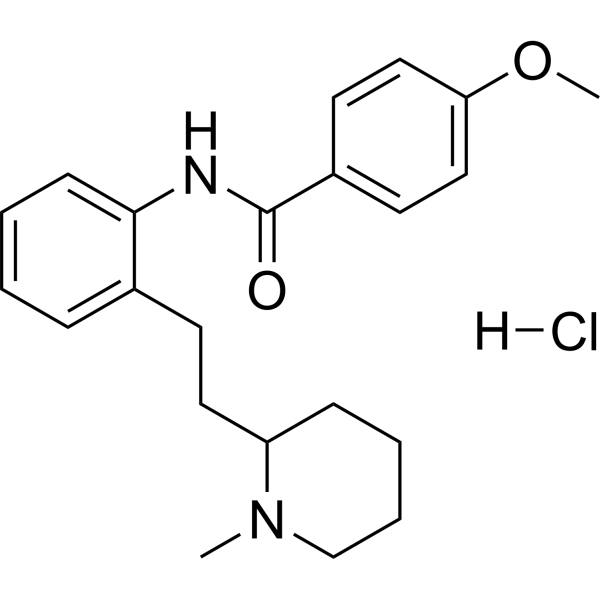
-
- HY-121460
-
-

-
- HY-101361
-
|
Methyllidocaine iodide
|
Others
|
Neurological Disease
|
|
Lidocaine methiodide (Methyllidocaine iodide) is a potent antiarrythmic agent. Lidocaine methiodide can be used for the research of ventricular arrhythmias produced by coronary occlusion .
|
-

-
- HY-119850
-
|
ARM036
|
Others
|
Cardiovascular Disease
|
|
Aladorian (ARM036) is a benzothiazepine derivative, with anti-arrhythmia effect. Aladorian is used for the research of heart failure and catecholaminergic polymorphic ventricular tachycardia .
|
-
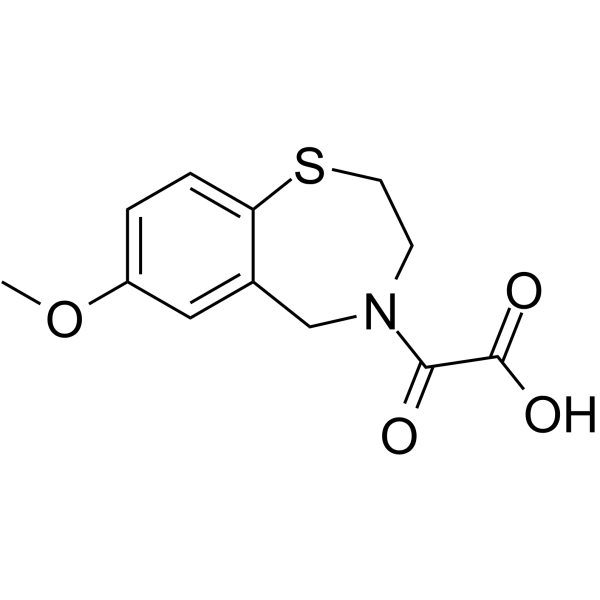
-
- HY-115839A
-
|
Detajmium bitartrate; Tachmalcor
|
Others
|
Cardiovascular Disease
|
|
Detajmium (L-tartrate) is an antiarrhythmic compound. Detajmium has effect on V max in both dog ventricular muscle and Purkinje fibers was frequency dependent .
|
-
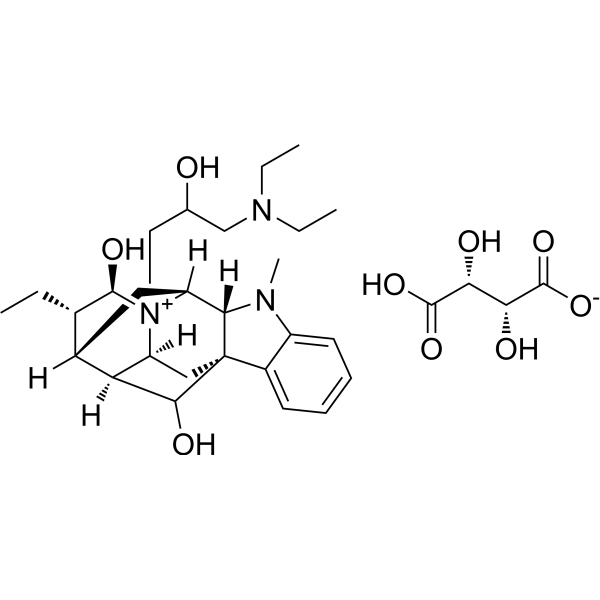
-
- HY-B1167
-
|
Cardiorythmine; (+)-Ajmaline
|
Sodium Channel
|
Cardiovascular Disease
|
|
Ajmaline (Cardiorythmine) is a sodium channel blocking, class 1A anti-arrhythmic agent. Ajmaline blocks HERG currents with an IC50 of 1 μM in HEK cells and 42.3 μM in Xenopus oocytes. Ajmaline can be used for the research of the ventricular tachyarrhythmia .
|
-

-
- HY-14304A
-
|
MJ 9184 hydrochloride
|
Adrenergic Receptor
|
Cardiovascular Disease
|
|
Zinterol hydrochloride (MJ 9184 hydrochloride) is a potent and selective β2-adrenoceptor agonist . Zinterol hydrochloride increases ICa in a concentration-dependent manner with an EC50 of 2.2 nM . Zinterol hydrochloride induces ventricular arrhythmias in conscious heart failure rabbits .
|
-
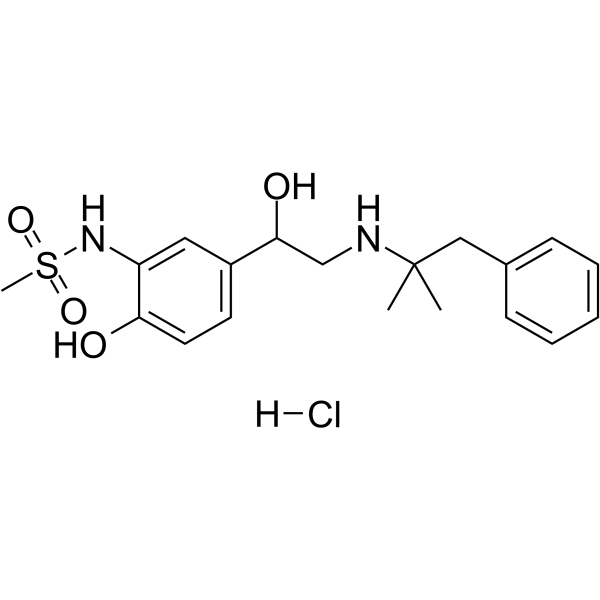
-
- HY-111013
-
|
|
Others
|
Cardiovascular Disease
|
|
VK-II-86 is a Carvedilol (HY-B0006) analogue lacking antagonist activity at β-adrenoceptors, in hypokalaemia. VK-II-86 prevents hypokalaemia-induced ventricular arrhythmia through multi-channel effects. VK-II-86 prevents all hypokalaemia-induced changes in ion channel activity and oxidative stress .
|
-
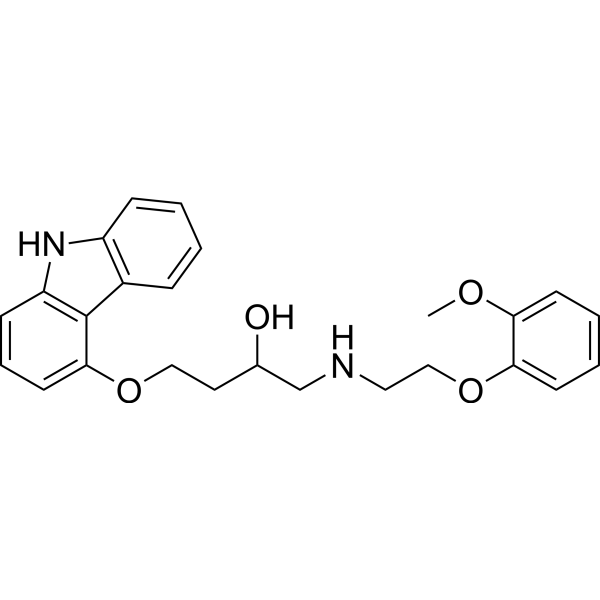
-
- HY-B0259
-
|
|
Potassium Channel
|
Cardiovascular Disease
|
|
Indapamide is an orally active sulphonamide diuretic agent, that can reduce blood pressure by decreasing vascular reactivity and peripheral vascular resistance. Indapamide is also can reduce left ventricular hypertrophy .
|
-
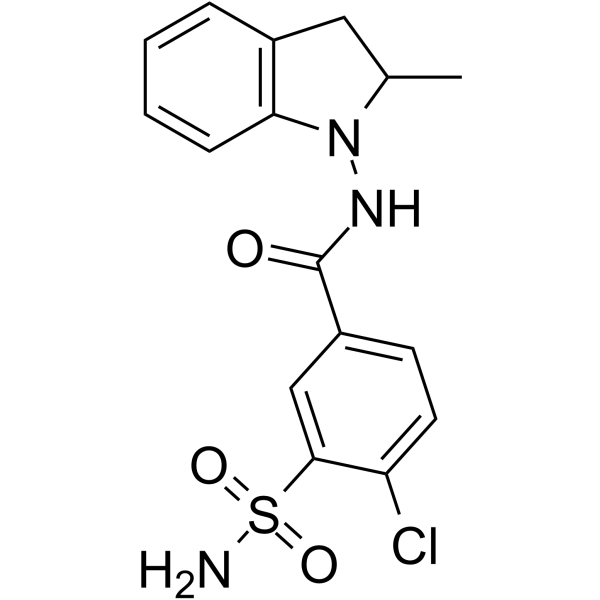
-
- HY-107335
-
|
Creatinol O-phosphate; Creatinol phosphate; Creatinolfosfate
|
Others
|
Cardiovascular Disease
|
|
Aplodan is an antiischemic and antiarrhythmic agent. Aplodan has a protective action on cell membrane. Aplodan has the potential for the research of ischemic heart or ischemic heart disease with persistent ventricular premature beats (VPB) .
|
-
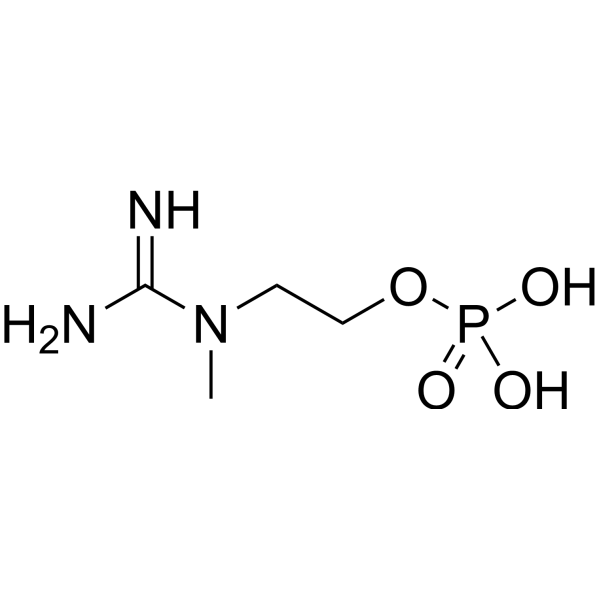
-
- HY-12533
-
|
Dicorantil; SC-7031
|
Sodium Channel
Potassium Channel
|
Cardiovascular Disease
|
|
Disopyramide (Dicorantil) is a class IA antiarrhythmic agent with efficacy in ventricular and atrial arrhythmias. Disopyramide blocks the fast inward sodium current of cardiac muscle and prolongs the duration of cardiac action potentials. Disopyramide inhibits HERG encoded potassium channels. Disopyramide also exhibits complex protein binding, and has a potent negative inotropic action .
|
-
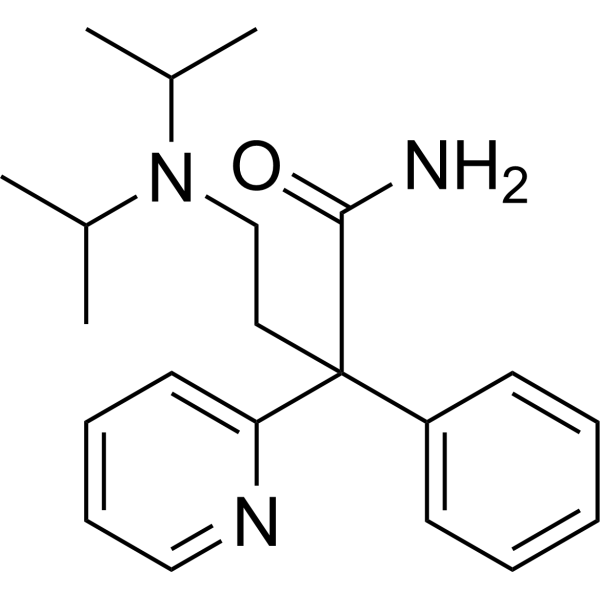
-
- HY-14188
-
|
|
Potassium Channel
Autophagy
|
Cardiovascular Disease
Cancer
|
|
Amiodarone hydrochloride, a benzofuran-based Class III antiarrhythmic agent, inhibits WT outwardIhERG tails with an IC50 of ∼45 nM . Amiodarone hydrochloride induces cell proliferation and myofibroblast differentiation via ERK1/2 and p38 MAPK signaling in fibroblasts . Amiodarone hydrochloride can be used in the research of both supraventricular and ventricular arrhythmias .
|
-
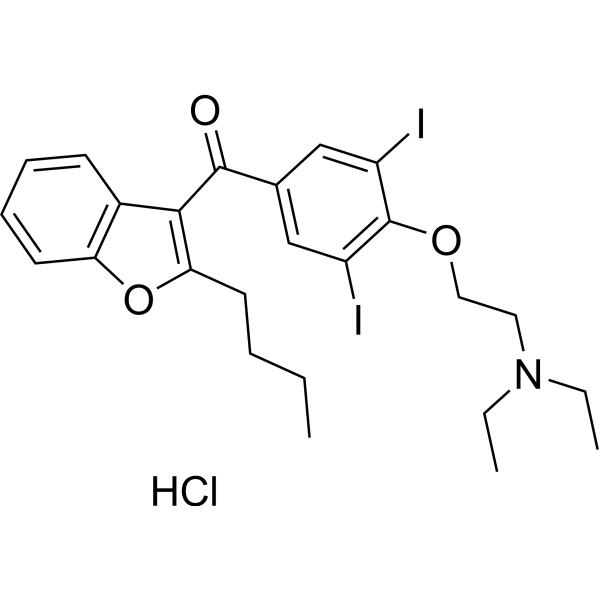
-
- HY-139727
-
|
|
Adrenergic Receptor
|
Cardiovascular Disease
|
|
S(-)-Bisoprolol is a S(-)-enantiomer of Bisoprolol. Bisoprolol is a potent, selective and orally active β1-adrenergic receptor blocker. Bisoprolol has little activity on β2-receptor and has the potential for hypertension, coronary artery disease and stable ventricular dysfunction research .
|
-
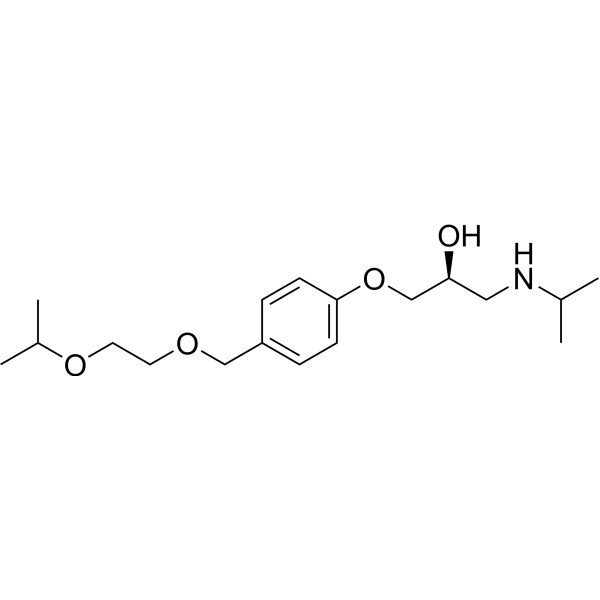
-
- HY-139727A
-
|
|
Adrenergic Receptor
|
Cardiovascular Disease
|
|
S(-)-Bisoprolol fumarate is a S(-)-enantiomer of Bisoprolol fumarate. Bisoprolol fumarate is a potent, selective and orally active β1-adrenergic receptor blocker. Bisoprolol has little activity on β2-receptor and has the potential for hypertension, coronary artery disease and stable ventricular dysfunction research .
|
-
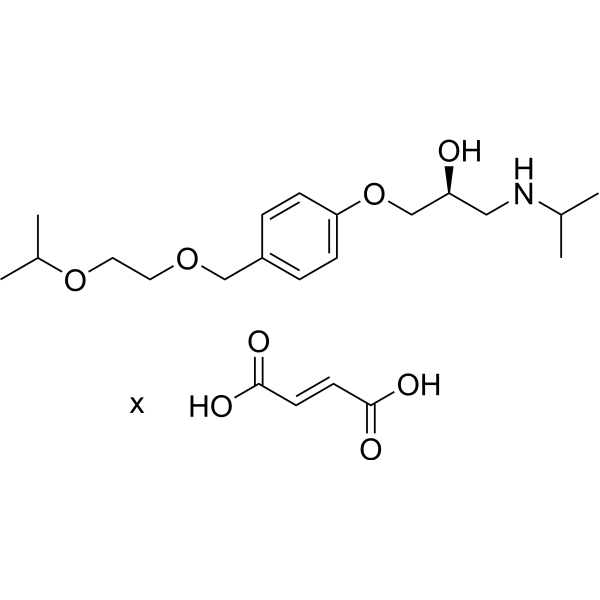
-
- HY-101415
-
|
Ubiquinone Q9; CoQ9; Ubiquinone 9
|
Apoptosis
Endogenous Metabolite
|
Cardiovascular Disease
|
|
Coenzyme Q9 (Ubiquinone Q9), the major form of ubiquinone in rodents, is an amphipathic molecular component of the electron transport chain that functions as an endogenous antioxidant. Coenzyme Q9 attenuates the diabetes-induced decreases in antioxidant defense mechanisms. Coenzyme Q9 improves left ventricular performance and reduces myocardial infarct size and cardiomyocyte apoptosis .
|
-
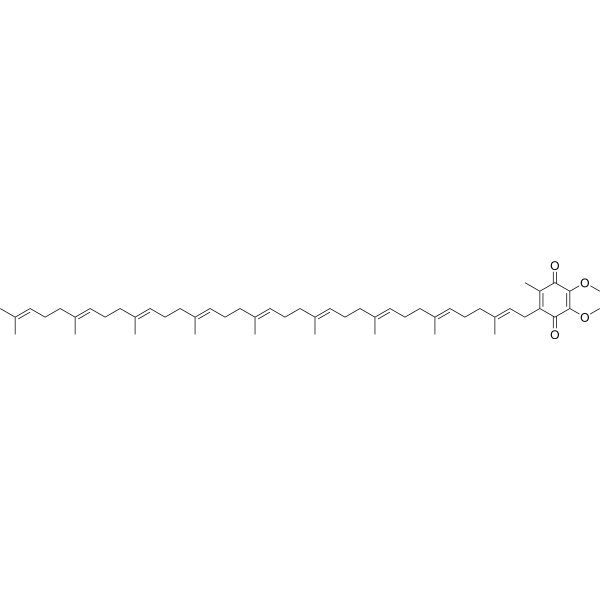
-
- HY-B1238
-
|
(±)-Pronethalo
|
Adrenergic Receptor
|
Cardiovascular Disease
Neurological Disease
|
|
Pronethalol ((±)-Pronethalo) is a non-selective β-adrenergic antagonist. Pronethalol is a potent inhibitor of Sox2 expression. Pronethalol protects against and to reverse Digitalis-induced ventricular arrhythmias and limits the cerebral arteriovenous malformation (AVMs) .
|
-
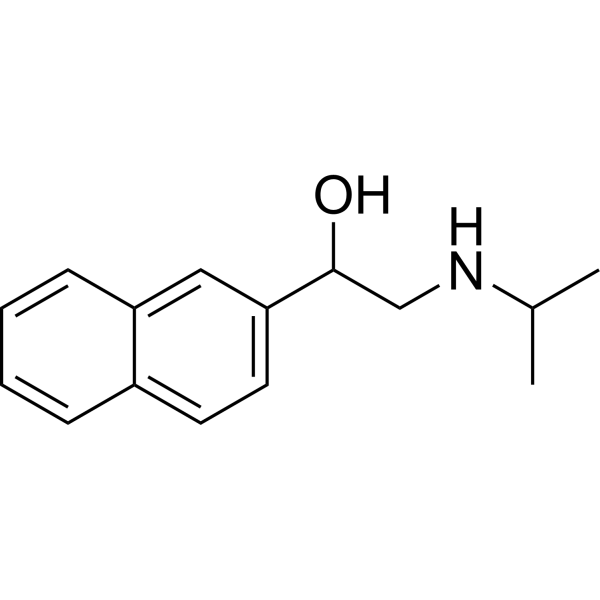
-
- HY-107428
-
|
|
MMP
|
Cardiovascular Disease
|
|
PD-166793 is a potent, selective, orally active and wide‐broad spectrum inhibitor of MMP, exhibiting nanomolar potency against MMP-2, MMP-3 and MMP-13 (IC50=4, 7, and 8 nM, respectively) and micromolar potency vs MMP-1, -7 and -9 (IC50=6.0, 7.2, and 7.9 μM, respectively). PD-166793 can attenuate left ventricular remodeling and dysfunction in a rat model of progressive heart failure .
|
-
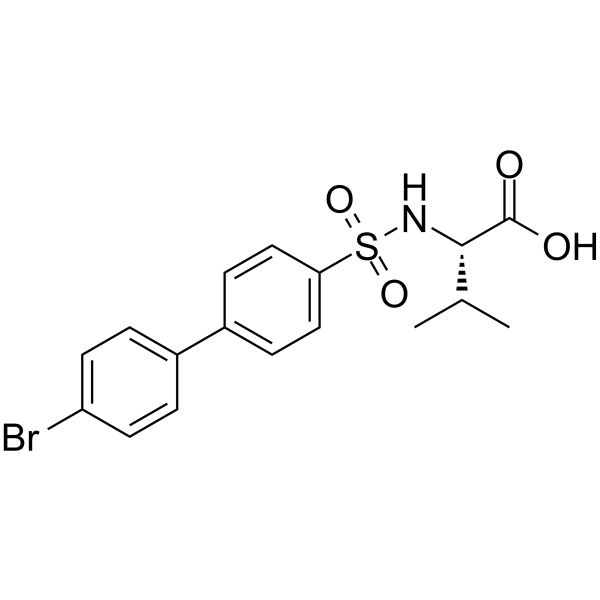
-
- HY-P3678
-
|
|
Neuropeptide Y Receptor
|
Cardiovascular Disease
Neurological Disease
|
|
Neuropeptide Y (18-36) (porcine) is a competitive neuropeptide Y (NPY) cardiac receptor antagonist. Neuropeptide Y (18-36) (porcine) inhibits the binding of I-NPY to cardiac ventricular membranes in a concentration-dependent manner with an IC50 value of 158 nM and an Ki value of 140 nM. Neuropeptide Y (18-36) (porcine) can be used for the research of congestive heart failure .
|
-

-
- HY-P5157
-
|
|
Potassium Channel
|
Neurological Disease
|
|
BmP02 is a selective Kv1.3 channel blocker and a highly-selective Kv4.2 modulator, which can be isolated from Chinese scorpion (Buthus martensi Karsch) venom. BmP02 also delays the inactivation of Kv4.2 in HEK293T cells, with an EC50 value of ~850 nM. BmP02 inhibits the transient outward potassium currents (Ito) in ventricular muscle cells .
|
-
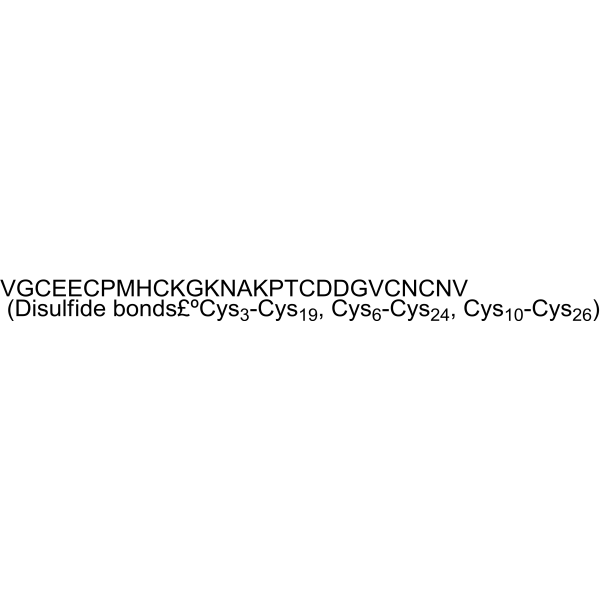
-
- HY-121306
-
|
Ricainide
|
Others
|
Neurological Disease
|
|
Indecainide (Ricainide) is an orally active antiarrhythmic agent. Indecainide can be used in the research of ventricular dysfunction .
|
-
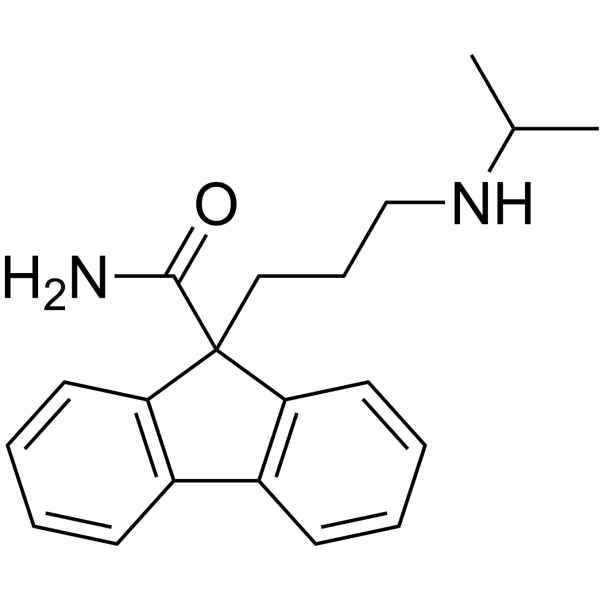
-
- HY-N0062
-
|
|
Others
|
Cardiovascular Disease
|
|
Angoroside C, a phenylpropanoid glycoside isolated from Scrophularia ningpoensis, has beneficial effects against ventricular remodeling .
|
-

-
- HY-B0432A
-
|
SA-79 hydrochloride
|
Sodium Channel
|
Cardiovascular Disease
|
|
Propafenone (hydrochloride) (SA-79 (hydrochloride)) is a class of anti-arrhythmic medication, which treats illnesses associated with rapid heart beats such as atrial and ventricular arrhythmias.
|
-
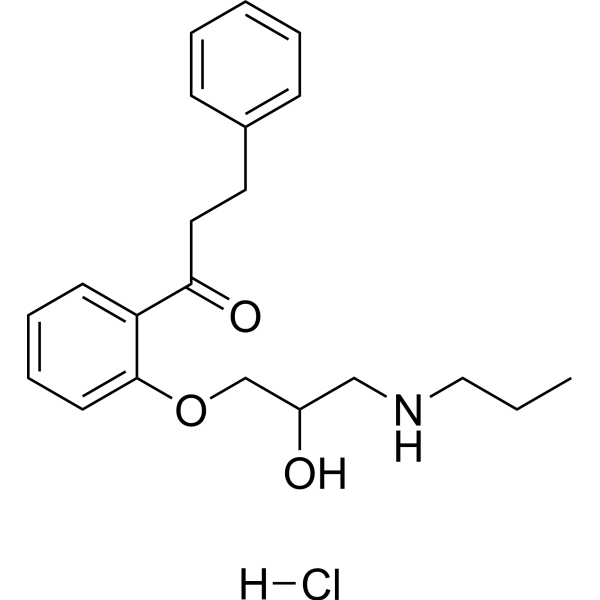
-
- HY-N1982
-
|
|
|
|
|
Denudatine, is primarily isolated from plants of the genera Aconitum and Delphinium . Denudatine has effects on action potential of ventricular fibers and inhibits arrhythmogenic action of aconitine .
|
-

-
- HY-123785
-
|
|
Na+/Ca2+ Exchanger
|
Metabolic Disease
|
|
ORM-10962 is a potent, highly selective sodium-calcium exchanger (NCX) inhibitor, with IC50 values of 67 and 55 nM for the reverse and forward mode inhibition, respectively. ORM-10962 shows antiarrhythmic effect .
|
-
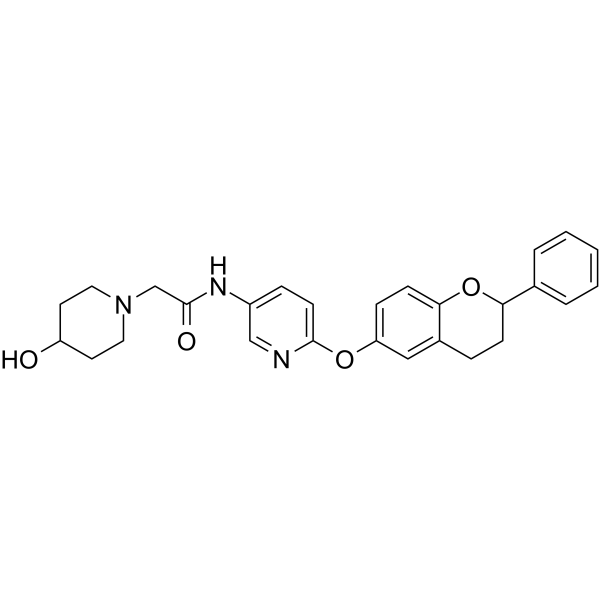
-
- HY-106369
-
|
|
Potassium Channel
|
Cardiovascular Disease
|
|
HMR 1556, a chromanol derivative, is a potent IKs blocker with IC50s of 10.5 nM and 34 nM in canine and guinea pig left ventricular myocytes, respectively .
|
-

-
- HY-12593
-
|
|
Sodium Channel
|
Cardiovascular Disease
|
|
GS967 (GS-458967) is a potent, and selective inhibitor of cardiac late sodium current (late INa ) with IC50 values of 0.13 and 0.21 μM for ventricular myocytes and isolated hearts, respectively.
|
-
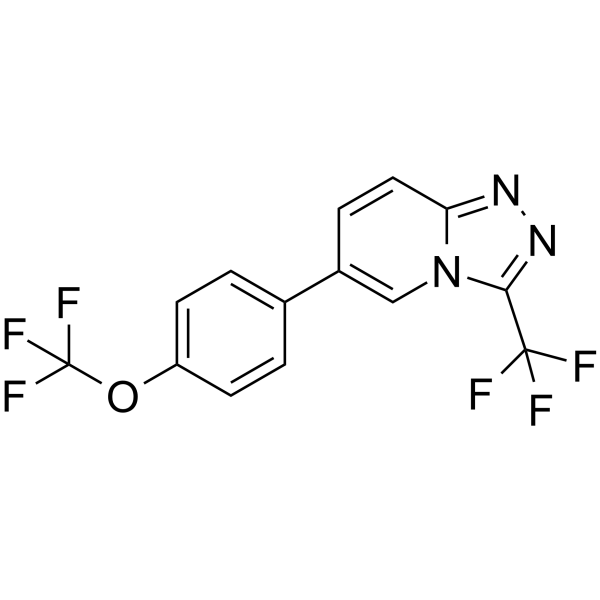
-
- HY-116759
-
-
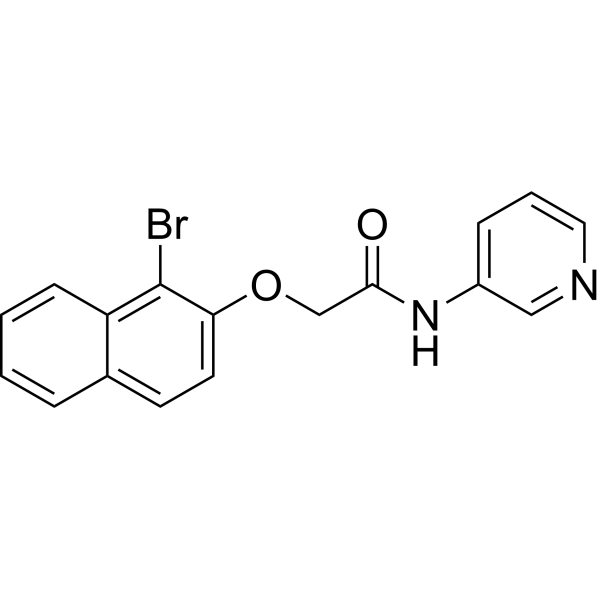
-
- HY-B0432AS2
-
|
|
Sodium Channel
|
Cardiovascular Disease
|
|
Propafenone-d5 (hydrochloride) is the deuterium labeled Propafenone hydrochloride. Propafenone (SA-79) hydrochloride is a class of anti-arrhythmic medication, which treats illnesses associated with rapid heart beats such as atrial and ventricular arrhythmias[1].
|
-
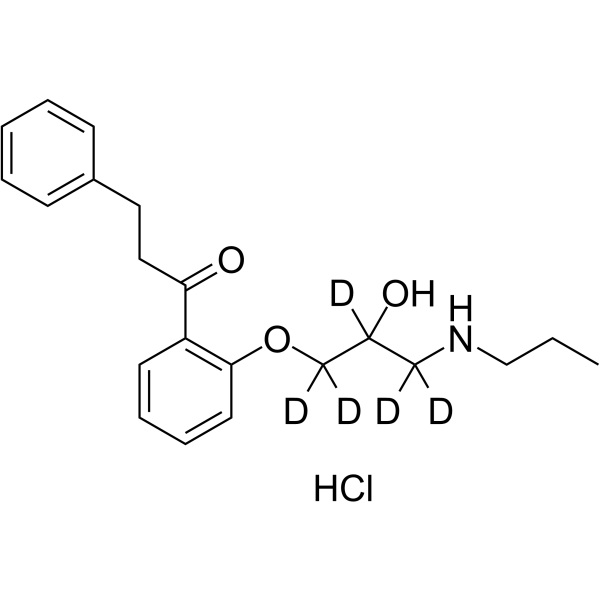
-
- HY-112075
-
|
|
Potassium Channel
Calcium Channel
|
Cardiovascular Disease
|
|
Lidoflazine is a high affinity blocker of the HERG (human ether-a-go-go-related gene) K + channel. Lidoflazine is an antianginal calcium channel blocker that carries a significant risk of QT interval prolongation and ventricular arrhythmia .
|
-
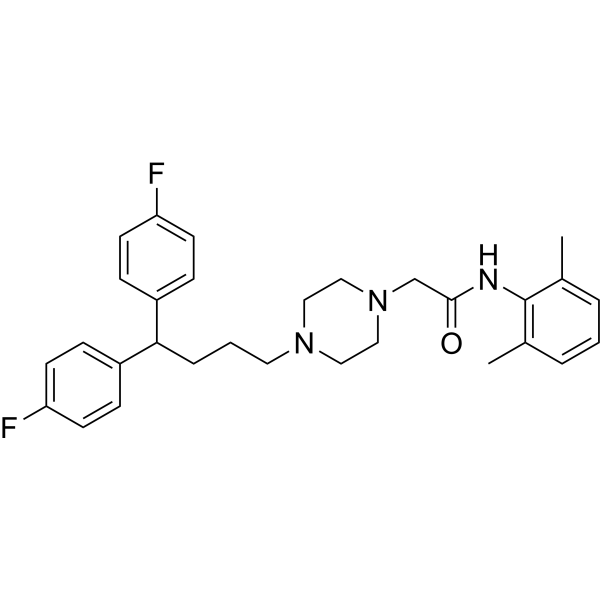
-
- HY-135121
-
|
Ethacizin; NIK-244
|
Sodium Channel
|
Cardiovascular Disease
|
|
Ethacizine hydrochloride (Ethacizin; NIK-244) is a longer-lasting Class Ic antiarrhythmic agent than Flecainide . Ethacizine hydrochloride (Ethacizin; NIK-244) inhibits the depolarizing current responsible for the intraatrial and His-Purkinje-ventricular conduction .
|
-
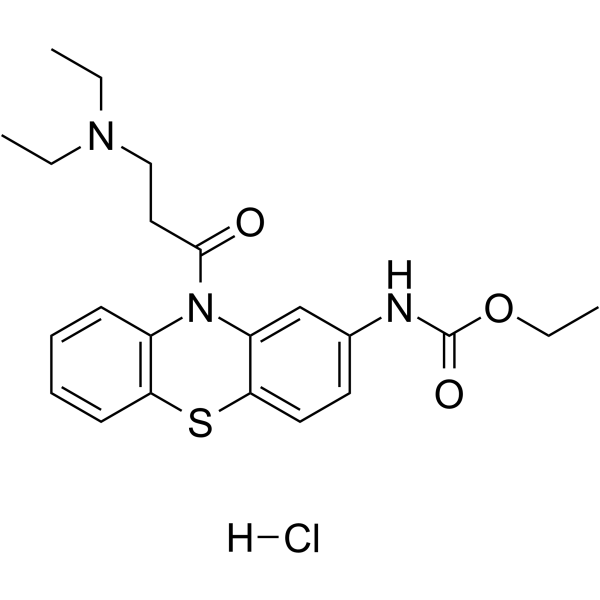
-
- HY-101366
-
-
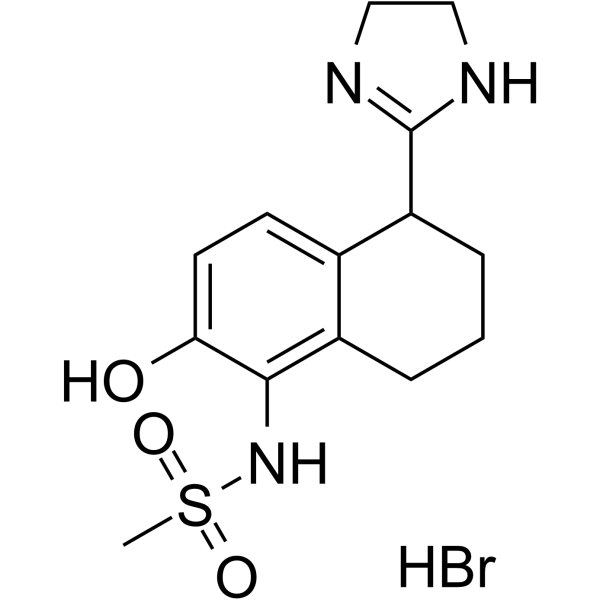
-
- HY-B0432AS4
-
|
|
Sodium Channel
|
Cardiovascular Disease
|
|
Propafenone-(phenyl-dd5) (hydrochloride) is the deuterium labeled Propafenone hydrochloride[1]. Propafenone hydrochloride is a class of anti-arrhythmic medication, which treats illnesses associated with rapid heart beats such as atrial and ventricular arrhythmias[2].
|
-
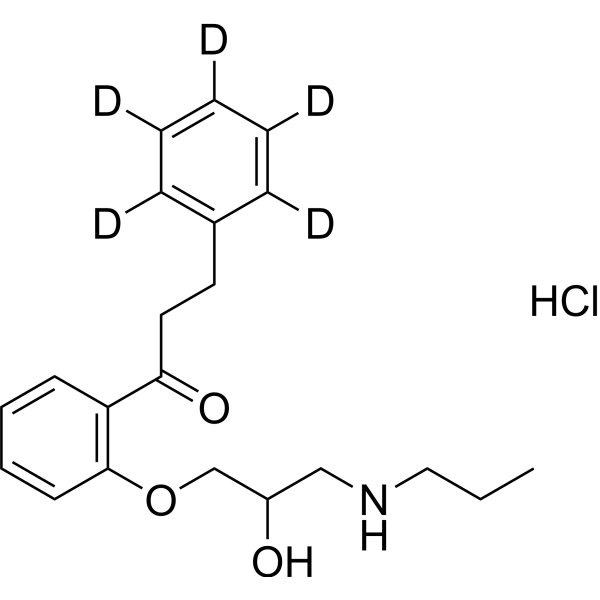
-
- HY-B0432AS3
-
|
|
Sodium Channel
|
Cardiovascular Disease
|
|
Propafenone-d5 Ethyl (hydrochloride) is the deuterium labeled Propafenone hydrochloride. Propafenone (SA-79)hydrochloride is a class of anti-arrhythmic medication, which treats illnesses associated with rapid heart beats such as atrial and ventricular arrhythmias[1].
|
-
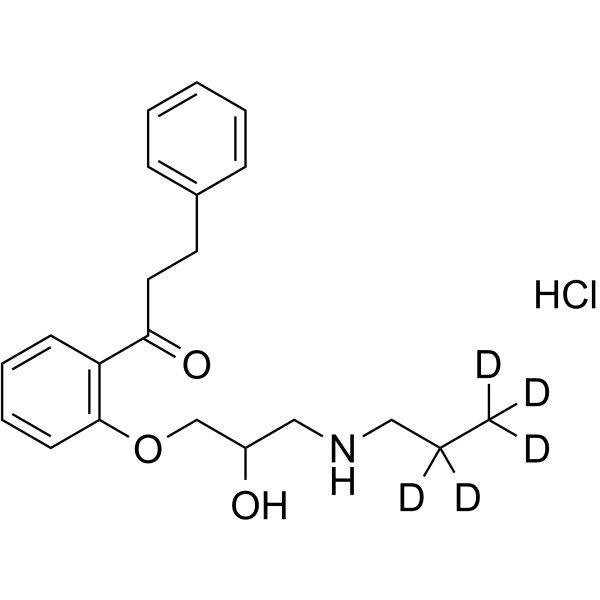
-
- HY-B1238A
-
|
(±)-Pronethalo hydrochloride
|
|
|
|
Pronethalol ((±)-Pronethalo) is a non-selective β-adrenergic antagonist. Pronethalol is a potent inhibitor of Sox2 expression. Pronethalol protects against and to reverse Digitalis-induced ventricular arrhythmias, and limits the cerebral arteriovenous malformation (AVMs) .
|
-
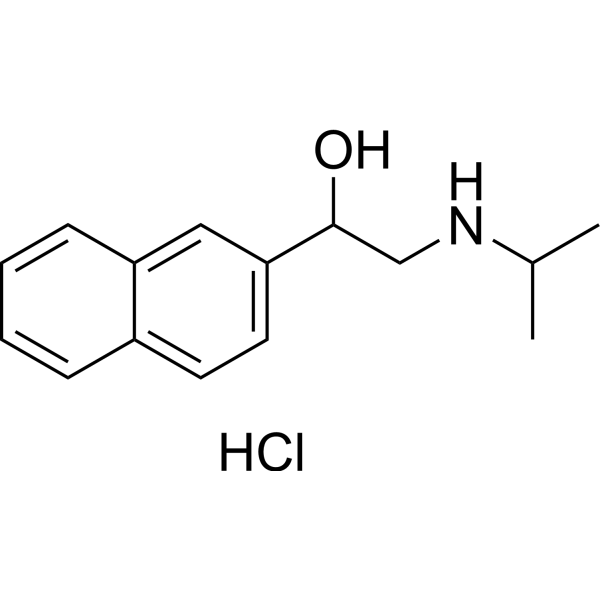
-
- HY-114683
-
|
|
Others
|
Cardiovascular Disease
|
|
KS370G is an orally active hypoglycemic and cardiovascular protective agent. KS370G improves left ventricular hypertrophy and function in pressure-overload mice heart. KS370G reduces renal obstructive nephropathy .
|
-
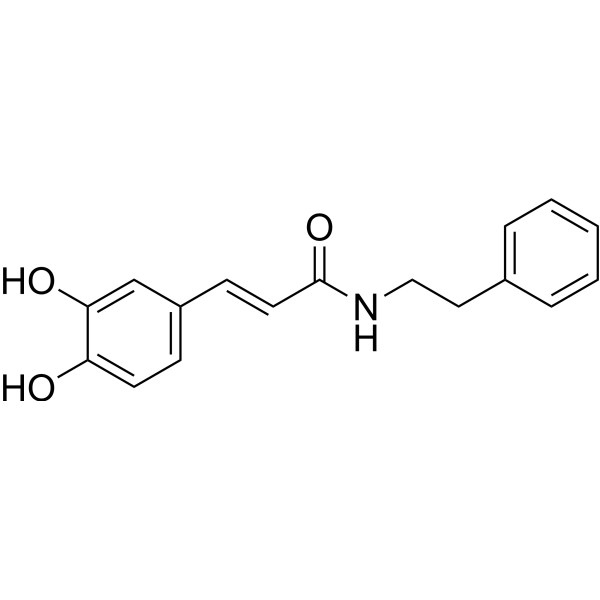
-
- HY-119817
-
|
BTS 49465; Flosequinon
|
Others
|
Cardiovascular Disease
|
|
Flosequinan is a balanced vasodilator. Flosequinan not only significantly reduces systemic vascular resistance, but also significantly reduces the beating component of left ventricular afterload, characteristic impedance and arterial wave reflection, which can be used in the research of acute heart failure .
|
-
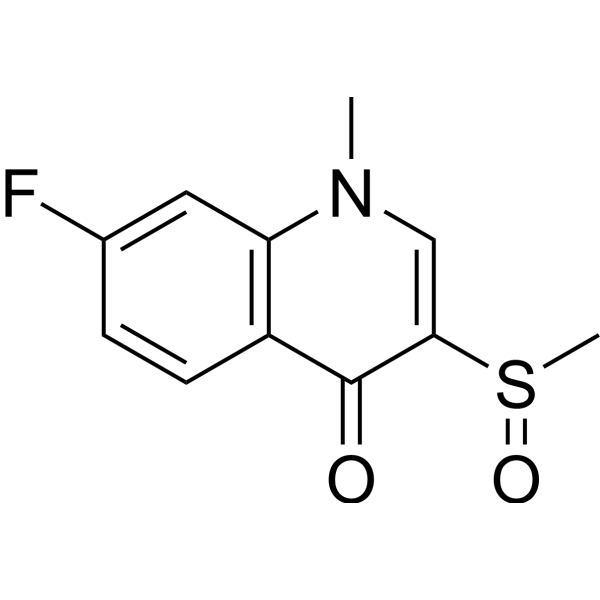
-
- HY-B0259S
-
|
|
Potassium Channel
|
Cardiovascular Disease
|
|
(rac)-Indapamide-d3 is a labelled racemic Indapamide. Indapamide is an orally active sulphonamide diuretic agent, that can reduce blood pressure by decreasing vascular reactivity and peripheral vascular resistance. Indapamide is also can reduce left ventricular hypertrophy[1][4].
|
-

-
- HY-129665
-
|
(±)-O,O-Dimethylcoclaurine
|
Endogenous Metabolite
|
Metabolic Disease
|
|
GS 389 ((±)-O,O-Dimethylcoclaurine) is a tetrahydroisoquinoline. GS-389 inhibites Cyclic AMP and cyclic AMP dependent phosphodiesterases from rat atrial and ventricular tissue. GS-389 relaxes the contraction induced by phenylephrine and high K + in rat aortic rings .
|
-

-
- HY-14304
-
|
MJ 9184
|
Adrenergic Receptor
|
Cardiovascular Disease
|
|
Zinterol (MJ 9184) is a potent and selective β2-adrenoceptor agonist . Zinterol increases ICa in a concentration-dependent manner with an EC50 of 2.2 nM .
|
-
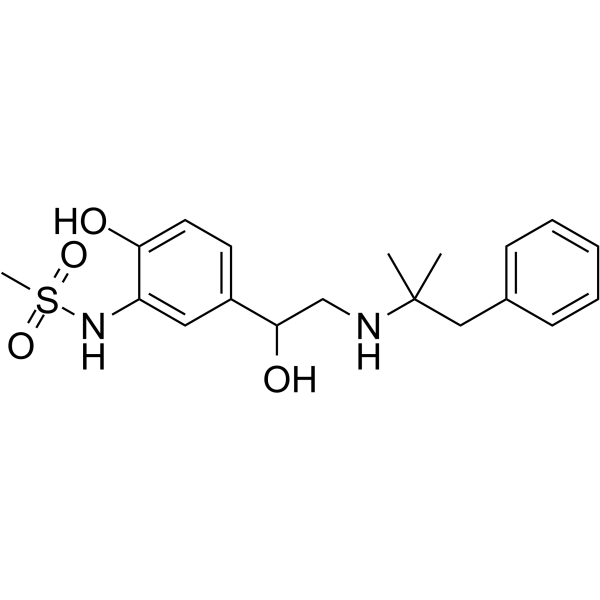
-
- HY-113673
-
|
|
Potassium Channel
|
Cardiovascular Disease
|
|
A-935142 is a human ether-a-go-go-related gene (hERG, Kv 11.1) channel activator. A-935142 enhances hERG current in a complex manner by facilitation of activation, reduction of inactivation, and slowing of deactivation, and abbreviates atrial and ventricular repolarization .
|
-
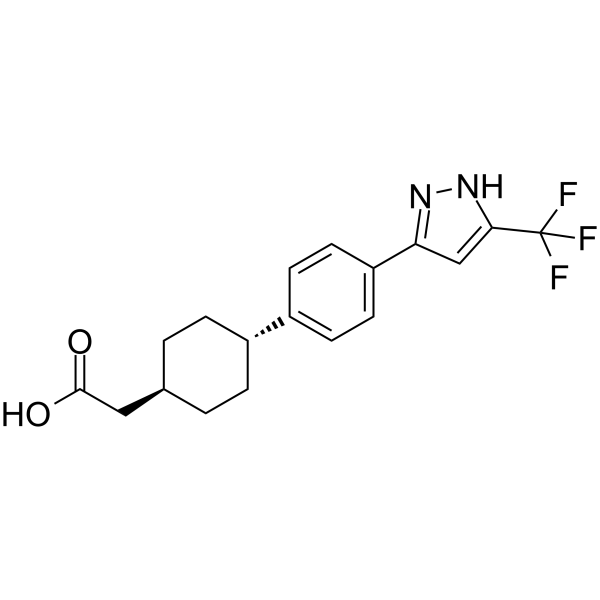
-
- HY-B0259R
-
|
|
Potassium Channel
|
Cardiovascular Disease
|
|
Indapamide (Standard) is the analytical standard of Indapamide. This product is intended for research and analytical applications. Indapamide is an orally active sulphonamide diuretic agent, that can reduce blood pressure by decreasing vascular reactivity and peripheral vascular resistance. Indapamide is also can reduce left ventricular hypertrophy .
|
-
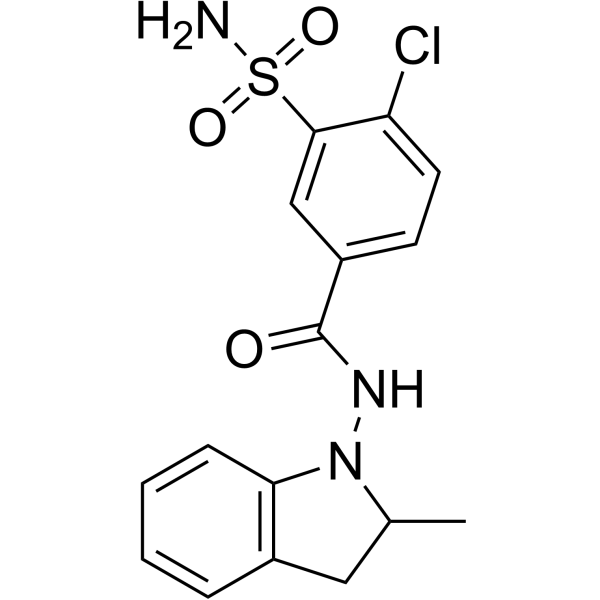
-
- HY-129029
-
-
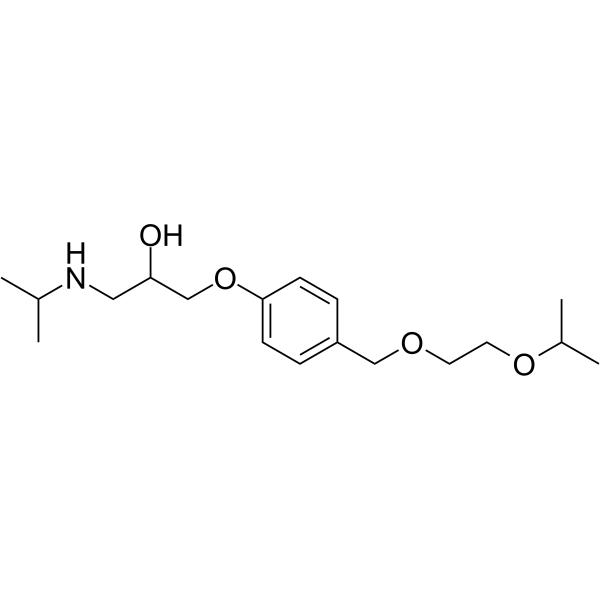
-
- HY-120829
-
-
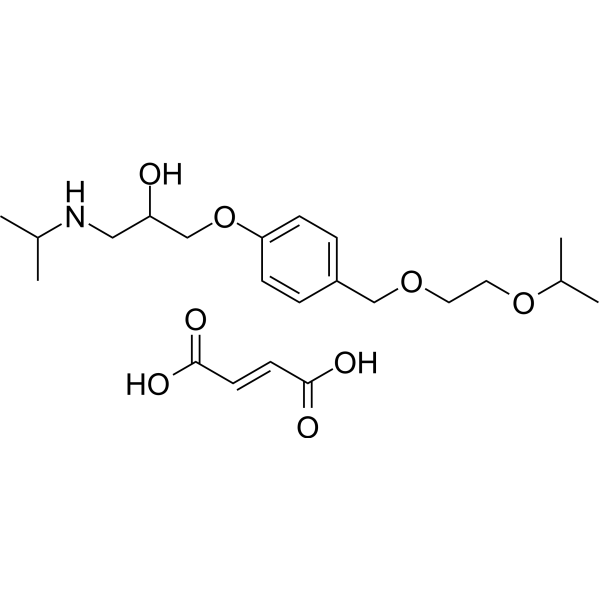
-
- HY-161119
-
|
|
Dynamin
Reactive Oxygen Species
|
Cardiovascular Disease
Cancer
|
|
Drpitor1a is a potent Drp1 inhibitor. Drpitor1a inhibits mitochondrial ROS production, preventes mitochondrial fission, and improves right ventricular diastolic dysfunction during IR (ischemia reperfusion) injury. Drpitor1a has the potential for the research of lung cancer [1]
|
-
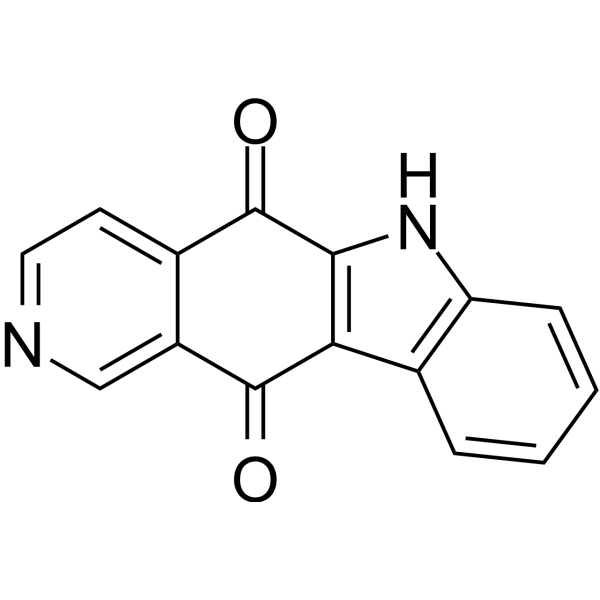
-
- HY-B0076
-
-
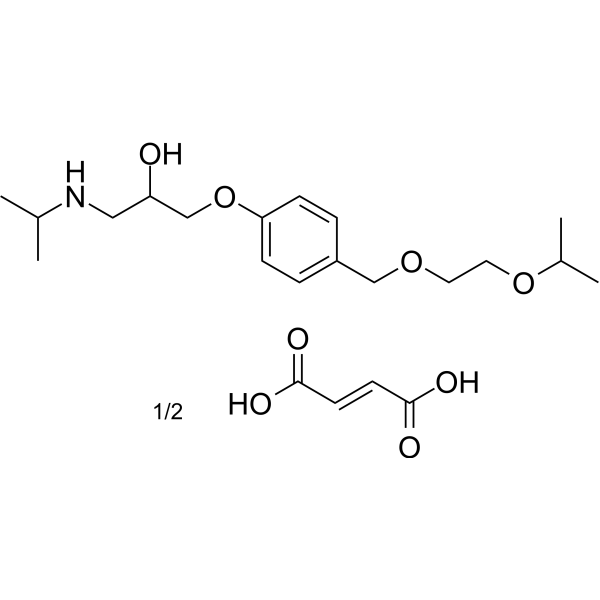
-
- HY-A0236A
-
|
|
Potassium Channel
|
Cardiovascular Disease
|
|
Aprindine hydrochloride is a class I-b anti-arrhythmic agent and a hERG channel blocker with an IC50 of 0.23 μM. Aprindine hydrochloride has inhibitory effects on Na+/Ca2+ exchanger currents, which is partly responsible for their antiarrhythmic and cardioprotective effects. Aprindine hydrochloride is widely used for trial and ventricular tachyarrhythmias research research.
|
-
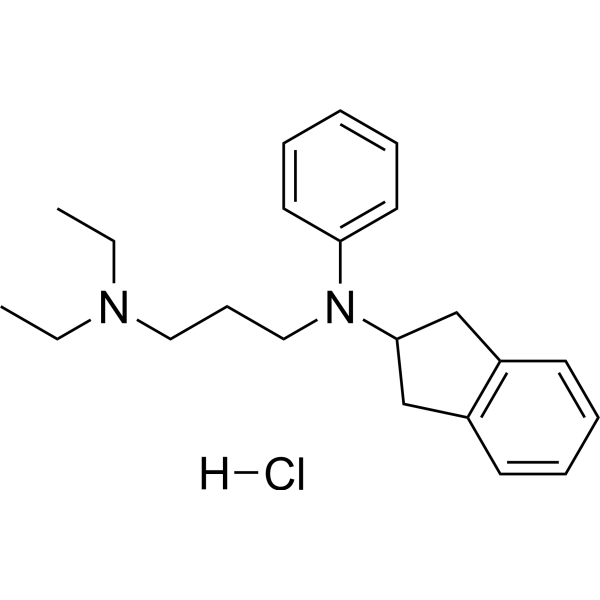
-
- HY-A0154
-
|
Deacetyllanatoside C; Desacetyllanatoside C
|
|
|
|
Deslanoside (Desacetyllanatoside C) is a rapidly acting cardiac glycoside used to treat congestive heart failure and supraventricular arrhythmias due to reentry mechanisms, and to control ventricular rate in the treatment of chronic atrial fibrillation. Deslanoside inhibits the Na-K-ATPase membrane pump, resulting in an increase in intracellular sodium and calcium concentrations .
|
-
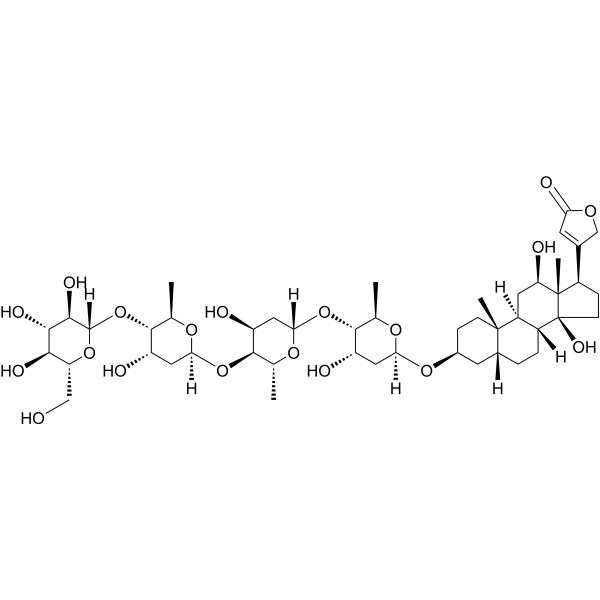
-
- HY-W010950A
-
|
|
Potassium Channel
Sodium Channel
|
Cardiovascular Disease
|
|
Flecainide hydrochloride is a potent and orally active antiarrhythmic agent. Flecainide hydrochloride blocks the cardiac fast inward Na + current (INa) and the rapid component of the delayed rectifier K + current. Flecainide hydrochloride prolongs the action potential duration (APD) in ventricular and atrial muscle fibres. Flecainide hydrochloride has the potential for the research of fetal tachycardias .
|
-
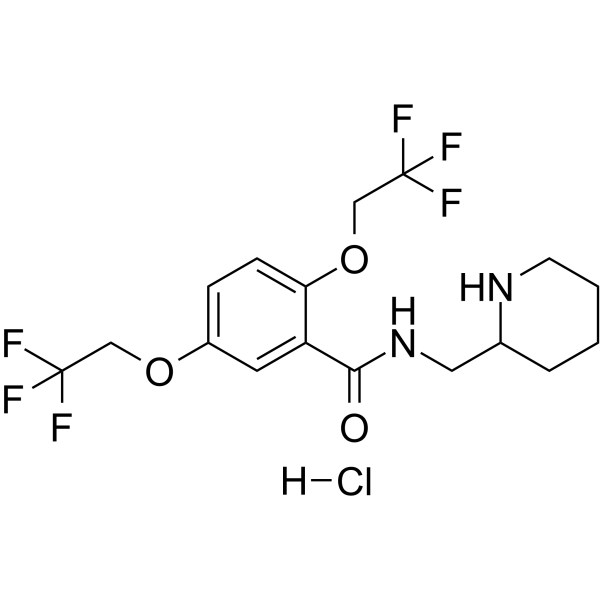
- HY-W010950
-
|
|
Potassium Channel
Sodium Channel
|
Cardiovascular Disease
|
|
Flecainide is a potent and orally active antiarrhythmic agent. Flecainide blocks the cardiac fast inward Na + current (INa) and the rapid component of the delayed rectifier K + current. Flecainide prolongs the action potential duration (APD) in ventricular and atrial muscle fibres. Flecainide has the potential for the research of fetal tachycardias .
|
-
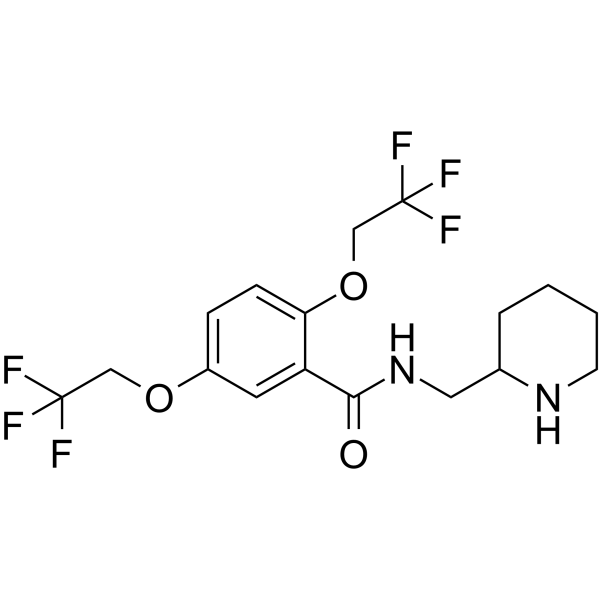
- HY-N2106
-
|
|
|
|
|
Dehydroevodiamine is a major bioactive quinazoline alkaloid isolated from Evodiae Fructus, has an antiarrhythmic effect in guinea-pig ventricular myocytes . Dehydroevodiamine inhibits LPS-induced iNOS, COX-2, prostaglandin E2 (PGE2) and nuclear factor-kappa B (NF-κB) expression in murine macrophage cells .
|
-
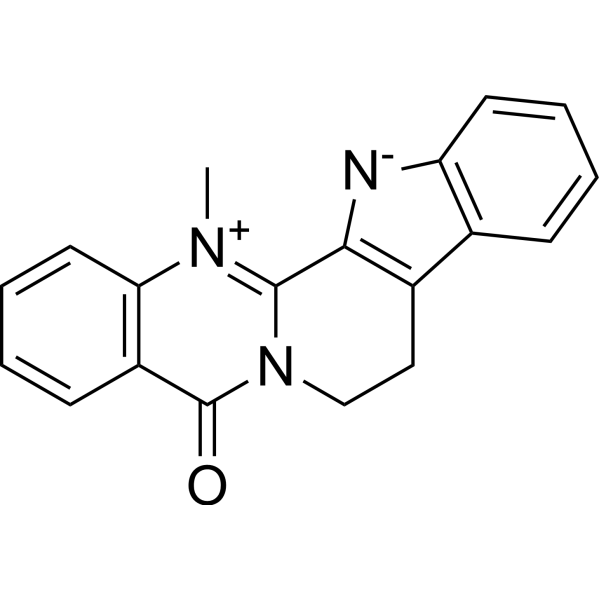
- HY-12533A
-
|
Dicorantil phosphate; SC-7031 phosphate
|
|
|
|
Disopyramide phosphate is a class IA antiarrhythmic agent with efficacy in ventricular and atrial arrhythmias. Disopyramide phosphate blocks the fast inward sodium current of cardiac muscle and prolongs the duration of cardiac action potentials. Disopyramide phosphate inhibits HERG encoded potassium channels. Disopyramide phosphate also exhibits complex protein binding, and has a potent negative inotropic action .
|
-

- HY-B0185
-
|
Lignocaine
|
Sodium Channel
MEK
ERK
NF-κB
Apoptosis
|
Cardiovascular Disease
Cancer
|
|
Lidocaine (Lignocaine) inhibits sodium channels involving complex voltage and using dependence . Lidocaine decreases growth, migration and invasion of gastric carcinoma cells via up-regulating miR-145 expression and further inactivation of MEK/ERK and NF-κB signaling pathways. Lidocaine is an amide derivative and has potential for the research of ventricular arrhythmia .
|
-
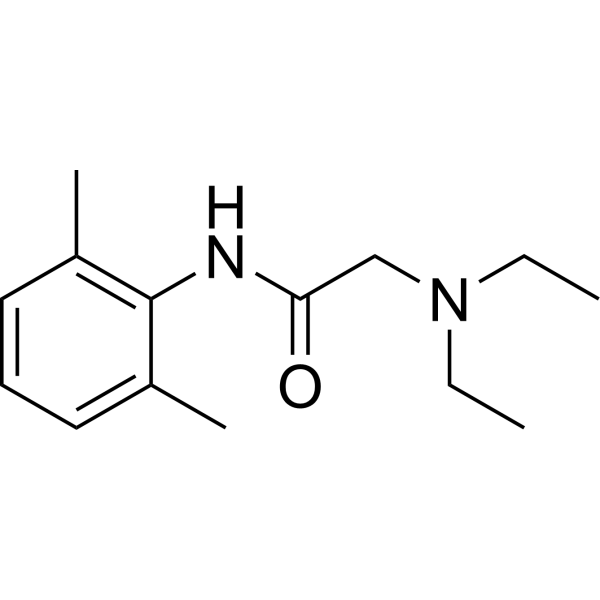
- HY-16952
-
|
(±)-Bepridil; Org 5730
|
Calcium Channel
Sodium Channel
SARS-CoV
|
Infection
Cardiovascular Disease
|
|
Bepridil ((±)-Bepridil) is a calcium channel blocking agent used as antiarrhythmic agent. Bepridil inhibits both calcium and sodium currents, has research potential in certain ischemia-induced ventricular arrhythmias. Bepridil also has strong inhibition of SARS-CoV-2 from entry and replication inside Vero E6 and A549 cells .
|
-
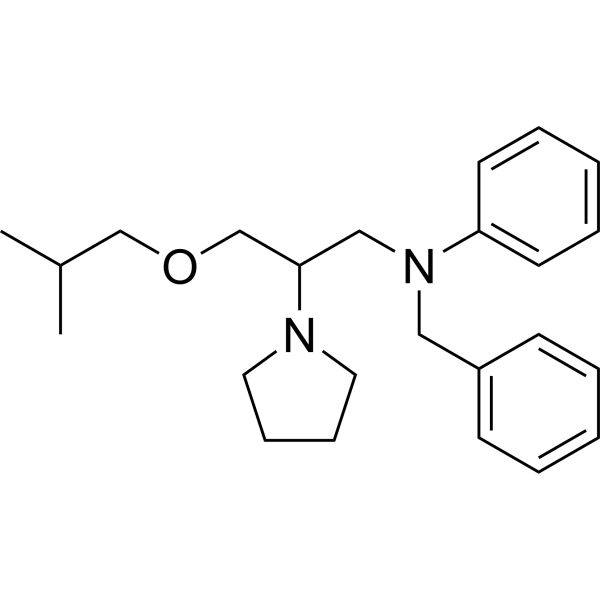
- HY-B0185B
-
|
Lignocaine hydrochloride hydrate
|
Sodium Channel
MEK
ERK
NF-κB
Apoptosis
|
Cardiovascular Disease
Cancer
|
|
Lidocaine (Lignocaine) hydrochloride hydrate inhibits sodium channels involving complex voltage and using dependence. Lidocaine hydrochloride hydrate decreases growth, migration and invasion of gastric carcinoma cells via up-regulating miR-145 expression and further inactivation of MEK/ERK and NF-κB signaling pathways. Lidocaine hydrochloride hydrate is an amide derivative and has potential for the research of ventricular arrhythmia .
|
-
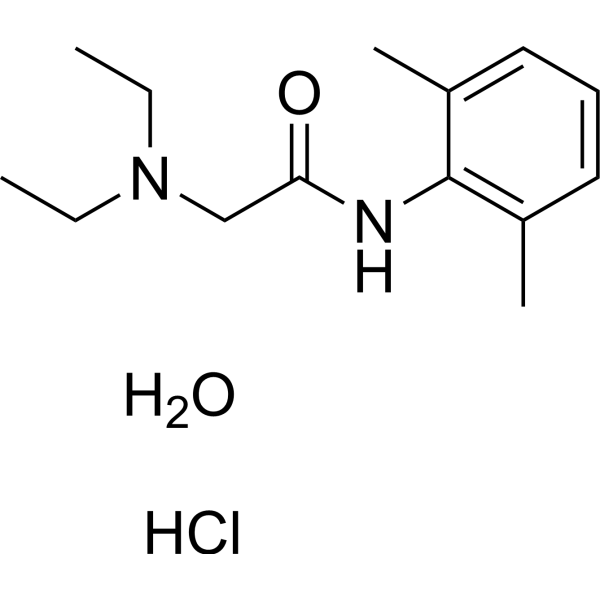
- HY-100952
-
|
|
|
|
|
Nifenalol hydrochloride is a β-adrenergic receptor antagonist. Nifenalol hydrochloride induces the Early Afterdepolarization (EAD) effect. EAD is a phenomenon in cardiac electrophysiology that usually occurs during an action potential in ventricular muscle cells and can lead to arrhythmia. The EAD effect of Nifenalol hydrochloride can be blocked by Tetrodotoxin. Nifenalol hydrochloride is used in the study of conditions such as irregular heartbeat or high blood pressure .
|
-
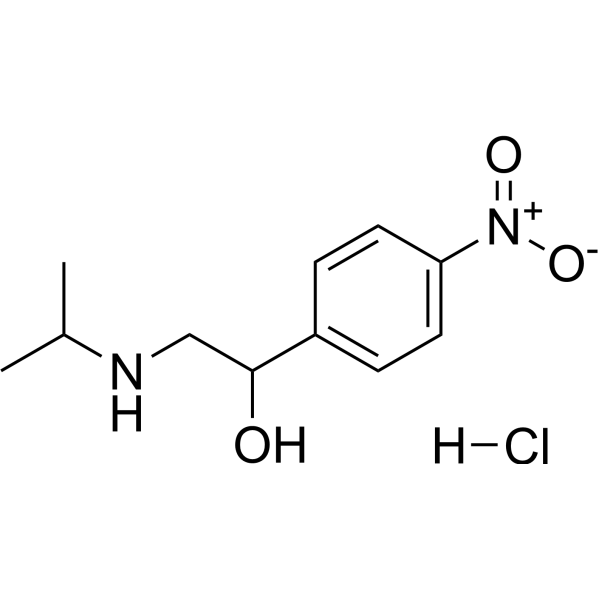
- HY-B0185A
-
|
Lignocaine hydrochloride
|
Sodium Channel
MEK
ERK
NF-κB
Apoptosis
|
Cardiovascular Disease
Cancer
|
|
Lidocaine hydrochloride (Lignocaine hydrochloride) inhibits sodium channels involving complex voltage and using dependence . Lidocaine hydrochloride decreases growth, migration and invasion of gastric carcinoma cells via up-regulating miR-145 expression and further inactivation of MEK/ERK and NF-κB signaling pathways. Lidocaine hydrochloride is an amide derivative and a agent to treat ventricular arrhythmia and an effective tumor-inhibitor .
|
-
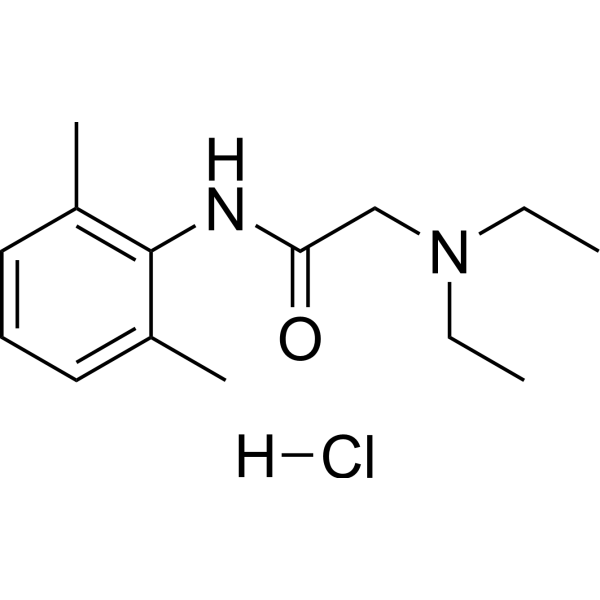
- HY-129029S
-
|
|
Isotope-Labeled Compounds
Adrenergic Receptor
|
Cardiovascular Disease
|
|
Bisoprolol-d5 is the deuterium labeled Bisoprolol. Bisoprolol is a potent, selective and orally active β1-adrenergic receptor blocker. Bisoprolol has little activity on β2-receptor and has the potential for hypertension, coronary artery disease and stable ventricular dysfunction research[1][2].
|
-
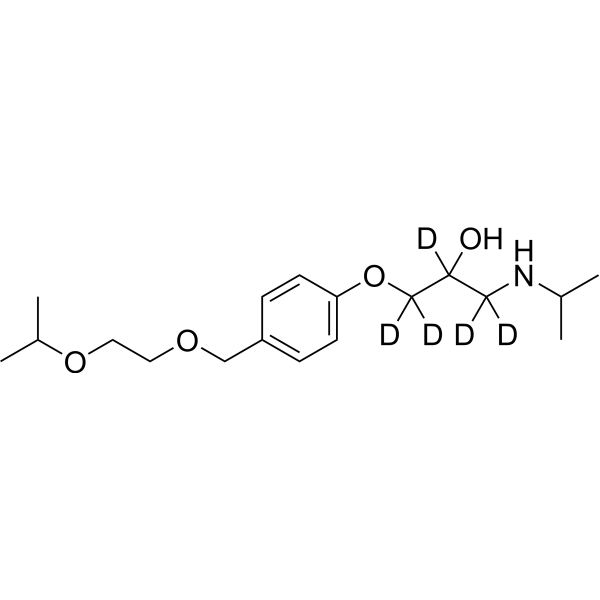
- HY-108591
-
|
R-L3
|
Potassium Channel
|
Cardiovascular Disease
|
|
L-364,373 (R-L3) is a voltage-gated Kv7.1 (KCNQ1)/mink channels activator. L-364,373 activates Iks (slow delayed rectifier potassium current) and shortens action potential duration in guinea pig cardiac myocytes, and suppresses early afterdepolarizations in rabbit ventricular myocytes .
|
-
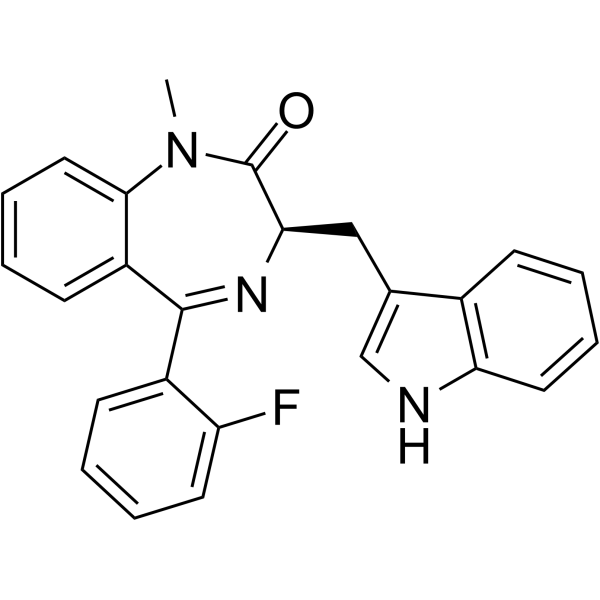
- HY-108584
-
|
BMS-204352
|
Potassium Channel
|
Neurological Disease
|
|
Flindokalner (BMS-204352) is a potassium channel modulator. Flindokalner is a positive modulator of all neuronal Kv7 channel subtypes expressed in HEK293 cells. Flindokalner is also a large conductance calcium-activated K channel (BKca) positive modulator. Flindokalner shows a negative modulatory activity at Kv7.1 channels (Ki=3.7 μM), and acts as a negative modulator of GABAA receptors. Flindokalner shows anxiolytic efficacy in vivo .
|
-

- HY-P4911
-
|
|
CXCR
|
Cardiovascular Disease
|
|
SDF-1α (human) is a mononuclear cells chemoattractant that can bind to CXCR4. SDF-1α plays a central role in stem cell homing, retention, survival, proliferation, cardiomyocyte repair, angiogenesis and ventricular remodelling following myocardial infarction. SDF-1α (human) can be used in cardiovascular disease research .
|
-
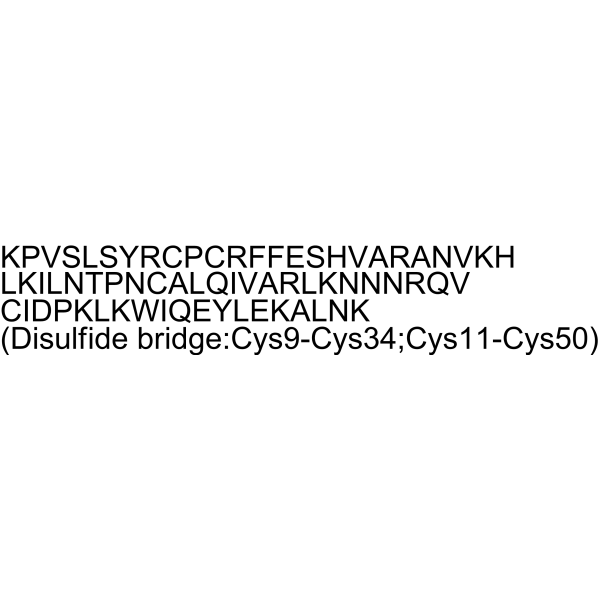
- HY-B0185AS
-
|
|
Sodium Channel
MEK
ERK
NF-κB
Apoptosis
|
Cardiovascular Disease
Cancer
|
|
Lidocaine-d10 (hydrochloride) is the deuterium labeled Lidocaine hydrochloride. Lidocaine hydrochloride (Lignocaine hydrochloride) inhibits sodium channels involving complex voltage and using dependence[1]. Lidocaine hydrochloride decreases growth, migration and invasion of gastric carcinoma cells via up-regulating miR-145 expression and further inactivation of MEK/ERK and NF-κB signaling pathways. Lidocaine hydrochloride, an amide derivative, has the potential for the research of the ventricular arrhythmia[2].
|
-
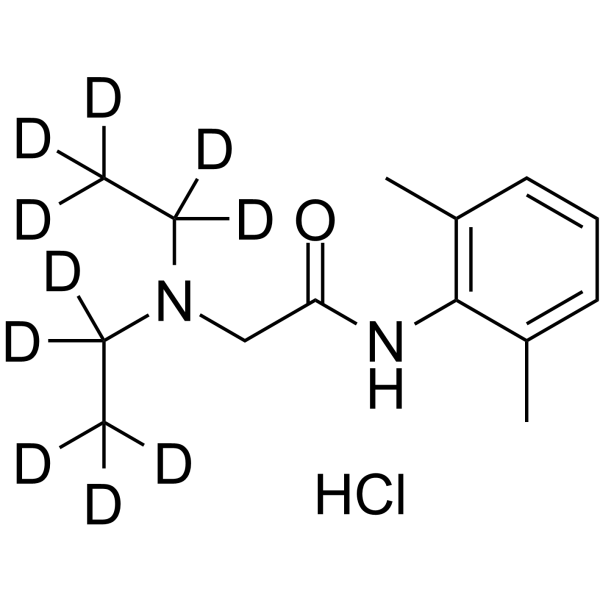
- HY-14188S
-
|
|
Potassium Channel
Autophagy
|
Cardiovascular Disease
Cancer
|
|
Amiodarone-d4 (hydrochloride) is the deuterium labeled Amiodarone hydrochloride. Amiodarone hydrochloride, a benzofuran-based Class III antiarrhythmic agent, inhibits WT outwardIhERG tails with an IC50 of ∼45 nM[1]. Amiodarone hydrochloride induces cell proliferation and myofibroblast differentiation via ERK1/2 and p38 MAPK signaling in fibroblasts[2]. Amiodarone hydrochloride can be used in the research of both supraventricular and ventricular arrhythmias[1].
|
-
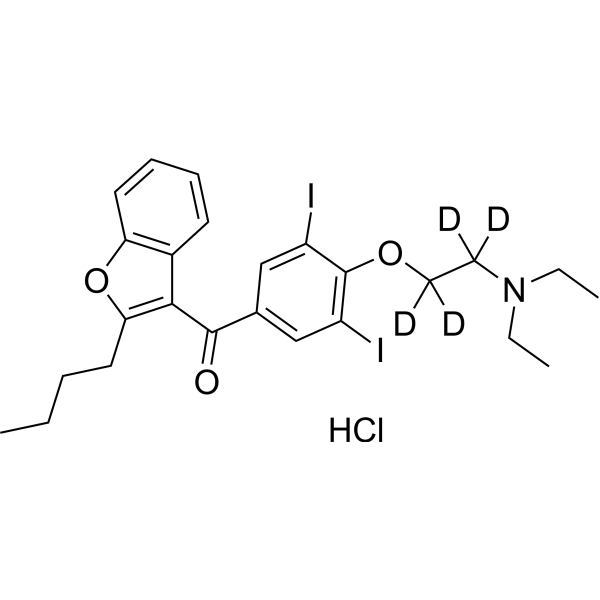
- HY-B0185S1
-
|
|
Sodium Channel
MEK
ERK
NF-κB
Apoptosis
|
Cardiovascular Disease
Cancer
|
|
Lidocaine-d10 is the deuterium labeled Lidocaine. Lidocaine (Lignocaine) inhibits sodium channels involving complex voltage and using dependence[1]. Lidocaine decreases growth, migration and invasion of gastric carcinoma cells via up-regulating miR-145 expression and further inactivation of MEK/ERK and NF-κB signaling pathways. Lidocaine is an amide derivative and has potential for the research of ventricular arrhythmia[2].
|
-
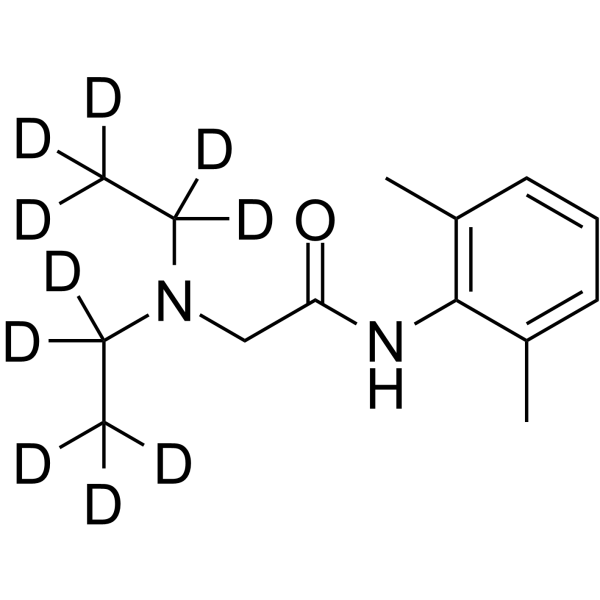
- HY-14188R
-
|
|
Potassium Channel
Autophagy
|
Cardiovascular Disease
Cancer
|
|
Amiodarone (hydrochloride) (Standard) is the analytical standard of Amiodarone (hydrochloride). This product is intended for research and analytical applications. Amiodarone hydrochloride, a benzofuran-based Class III antiarrhythmic agent, inhibits WT outwardIhERG tails with an IC50 of ∼45 nM . Amiodarone hydrochloride induces cell proliferation and myofibroblast differentiation via ERK1/2 and p38 MAPK signaling in fibroblasts . Amiodarone hydrochloride can be used in the research of both supraventricular and ventricular arrhythmias .
|
-

- HY-B0185S
-
|
|
Sodium Channel
MEK
ERK
NF-κB
Apoptosis
|
Cardiovascular Disease
Cancer
|
|
N-Oxide Lidocaine-d10 is the deuterium labeled Lidocaine. Lidocaine (Lignocaine) inhibits sodium channels involving complex voltage and using dependence[1]. Lidocaine decreases growth, migration and invasion of gastric carcinoma cells via up-regulating miR-145 expression and further inactivation of MEK/ERK and NF-κB signaling pathways. Lidocaine is an amide derivative and has potential for the research of ventricular arrhythmia[2].
|
-
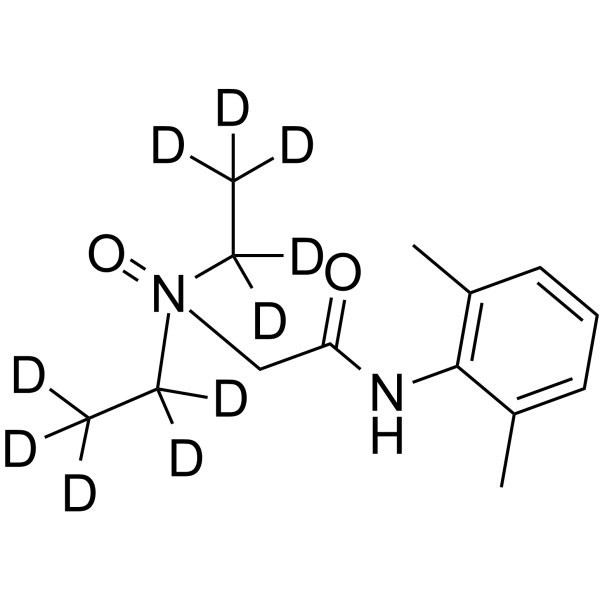
- HY-B0185AS1
-
|
Lignocaine-d6 hydrochloride
|
Sodium Channel
MEK
ERK
NF-κB
Apoptosis
|
Cardiovascular Disease
Cancer
|
|
Lidocaine-d6 (hydrochloride) is deuterium labeled Lidocaine (hydrochloride). Lidocaine hydrochloride (Lignocaine hydrochloride) inhibits sodium channels involving complex voltage and using dependence[1]. Lidocaine hydrochloride decreases growth, migration and invasion of gastric carcinoma cells via up-regulating miR-145 expression and further inactivation of MEK/ERK and NF-κB signaling pathways. Lidocaine hydrochloride is an amide derivative and a agent to treat ventricular arrhythmia and an effective tumor-inhibitor[2].
|
-

- HY-B0185R
-
|
Lignocaine (Standard)
|
Sodium Channel
MEK
ERK
NF-κB
Apoptosis
|
Cardiovascular Disease
Cancer
|
|
Lidocaine (Standard) is the analytical standard of Lidocaine. This product is intended for research and analytical applications. Lidocaine (Lignocaine) inhibits sodium channels involving complex voltage and using dependence . Lidocaine decreases growth, migration and invasion of gastric carcinoma cells via up-regulating miR-145 expression and further inactivation of MEK/ERK and NF-κB signaling pathways. Lidocaine is an amide derivative and has potential for the research of ventricular arrhythmia .
|
-
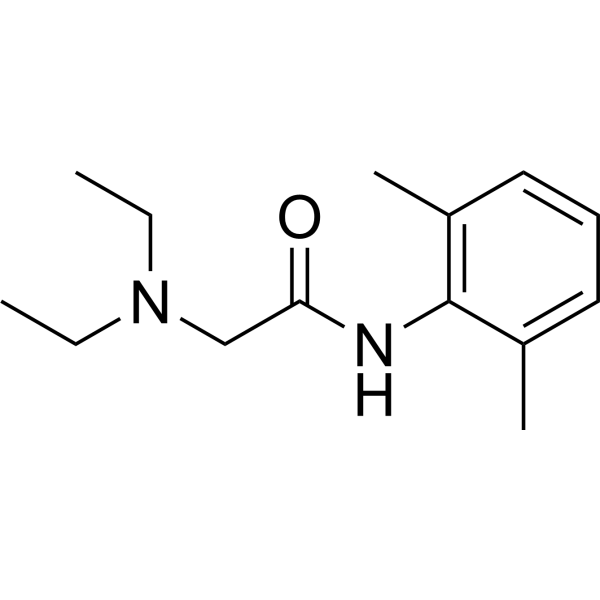
- HY-W145695
-
|
|
Biochemical Assay Reagents
|
Inflammation/Immunology
|
|
Chitoheptaose is a chitosan oligosaccharide. Chitoheptaose is capable of extracting exoskeletons from crustaceans, such as the shells of crabs, shrimp and lobsters. Chitoheptaose has antioxidant, anti-inflammatory and anti-apoptotic activities and can be used in the study of myocarditis. Chitoheptaose has cardioprotective effects and improves cardiac parameters (left ventricular internal size, end-systolic and end-diastolic, ejection fraction and shortening fraction), inflammatory cytokines (IL-1β) in vanishing models .
|
-
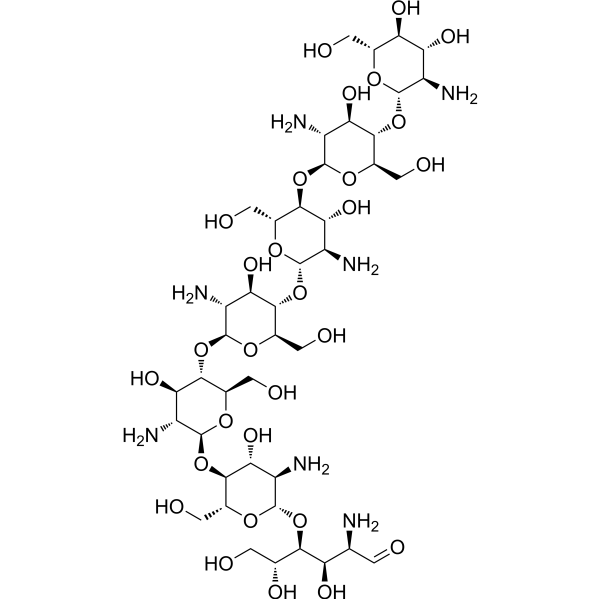
- HY-P5904
-
|
Caveolin-1 scaffolding domain peptide
|
c-Met/HGFR
|
Others
|
|
Caveolin-1 (82-101) amide (human, mouse, rat) (Caveolin-1 scaffolding domain peptide) is a peptide that reverses aging-associated deleterious changes in multiple organs. Caveolin-1 (82-101) amide (human, mouse, rat) inhibits tyrosine kinases .
|
-
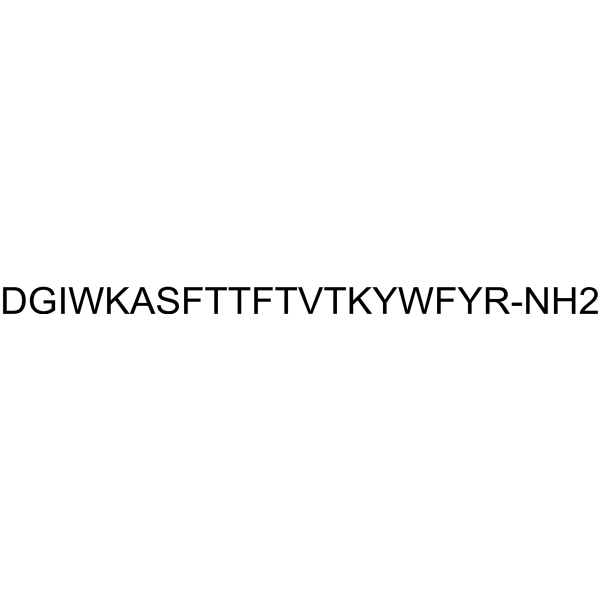
- HY-129763
-
|
|
Fluorescent Dye
|
Others
|
|
Di-4-ANEPPS is a voltage-sensitive dye in membrane potential. Di-4-ANEPPS allows reaching a time resolution better than 1 ms and exhibits changes in fluorescence of up to 10% per 100 mV. Di-4-ANEPPS is a common tool for mapping cardiac electrical activity. Di-4-ANEPPS demonstrate significant direct irreversible effect on spontaneous heart rate and ventricular impulse conduction in rabbit isolated heart model .
|
-
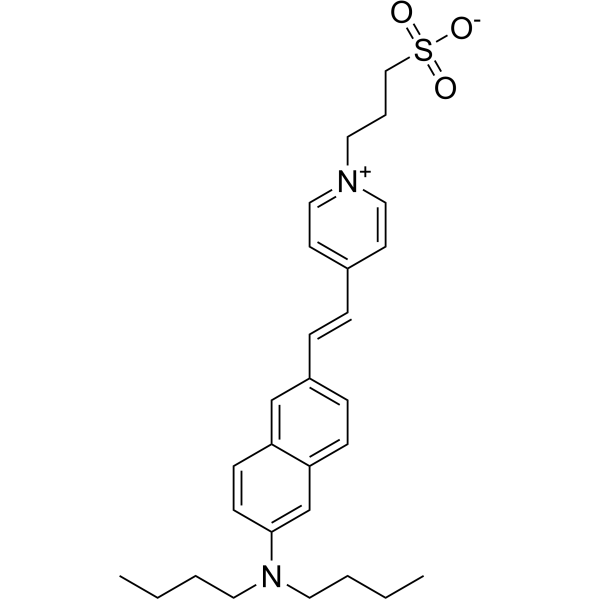
- HY-B0185G
-
|
Lignocaine
|
Apoptosis
Sodium Channel
MEK
ERK
NF-κB
|
Cancer
|
|
Lidocaine (GMP) is Lidocaine (HY-B0185) produced by using GMP guidelines. GMP small molecules work appropriately as an auxiliary reagent for cell therapy manufacture. Lidocaine inhibits sodium channels involving complex voltage and using dependence . Lidocaine decreases growth, migration and invasion of gastric carcinoma cells via up-regulating miR-145 expression and further inactivation of MEK/ERK and NF-κB signaling pathways. Lidocaine is an amide derivative and has potential for the research of ventricular arrhythmia .
|
-
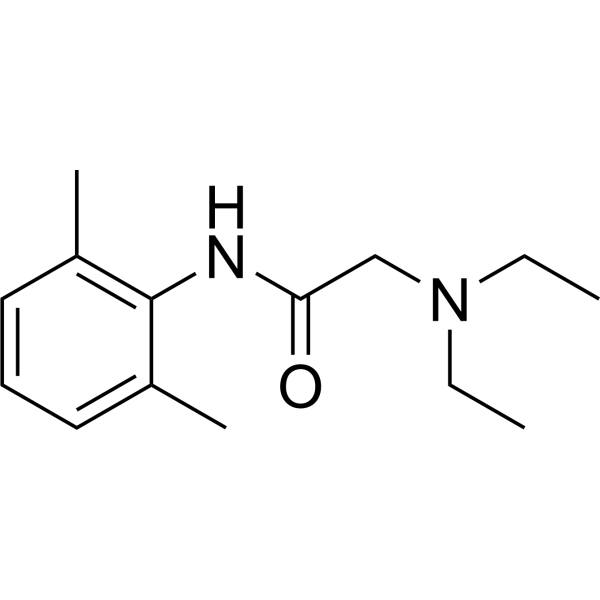
- HY-163120
-
|
|
Myosin
|
Cardiovascular Disease
|
|
Myosin-IN-1 (compound F10) is a Myosin inhibitor that specifically targets cardiac myosin. Myosin-IN-1 stabilizes the biochemical and structural closed state of the cardiac myosin motor domain and reduces myocardial force production and calcium sensitivity in vitro. Myosin-IN-1 acts as a negative inotropic agent in isolated Langendroff-perfused rat hearts, reducing stress in isolated myofilaments and left ventricular pressure development. Myosin-IN-1 can be used in heart failure research .
|
-
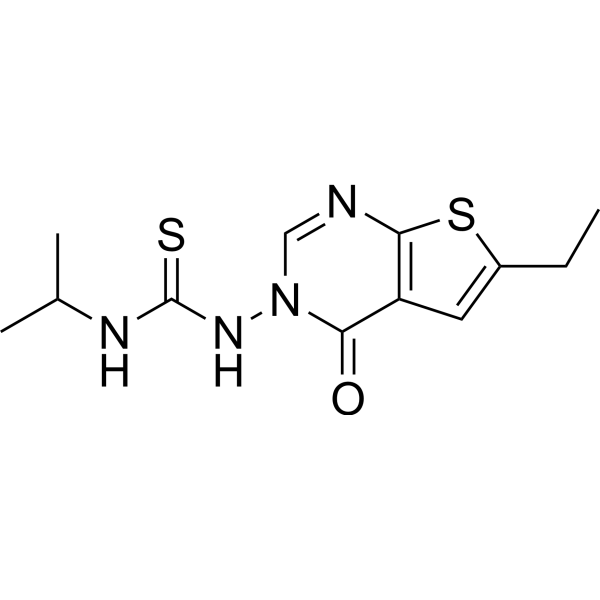
- HY-17403
-
|
CV-4093
|
Calcium Channel
NF-κB
|
Infection
Cardiovascular Disease
Metabolic Disease
Inflammation/Immunology
|
|
Manidipine dihydrochloride is a third-generation, lipophilic, orally active and highly vasoselective calcium channel antagonist (IC50 = 2.6 nM in guinea-pig ventricular cells) and acts as an antihypertensive agent. Manidipine effectively reduces blood pressure as well as improving insulin sensitivity, renal protection, and antiatherosclerotic activity. Manidipine also exerts anti-inflammatory activity mediated by NF-κB and antiviral activity against many flavivirus and negative-strand RNA viruses through the inhibition of calcium channel. Manidipine is widely applied to research of cardiovascular, metabolic disease and infection .
|
-
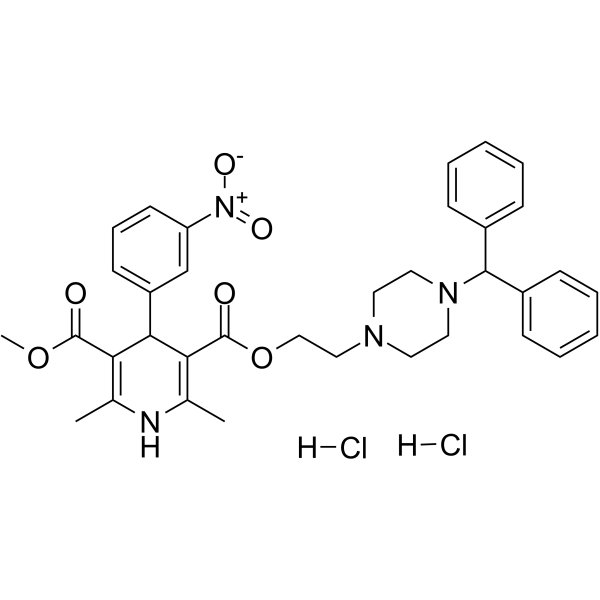
- HY-106994
-
|
YM598 free base
|
Endothelin Receptor
|
Cardiovascular Disease
Inflammation/Immunology
|
|
Nebentan (YM598 free base) is a potent, selective and orally active non-peptide endothelin ETA receptor antagonist through the modification of Bosentan (HY-A0013). Nebentan inhibits [ 125I] endothelin-1 binding to cloned human endothelin ETA and ETB receptor, with Ki of 0.697 nM and 569 nM, respectively . YM598 can ameliorate the progression of cor pulmonale and myocardial infarction in vivo .
|
-
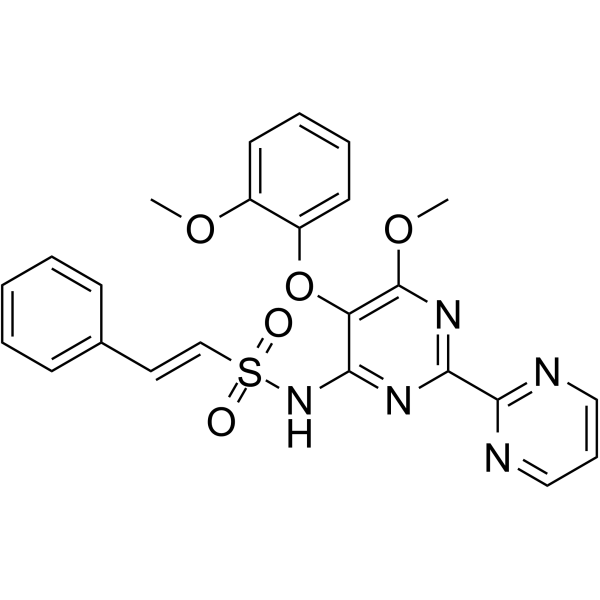
- HY-106994A
-
|
YM598
|
Endothelin Receptor
|
Cardiovascular Disease
Inflammation/Immunology
|
|
Nebentan potassium (YM598) is a potent, selective and orally active non-peptide endothelin ETA receptor antagonist through the modification of Bosentan (HY-A0013). Nebentan potassium inhibits [ 125I] endothelin-1 binding to cloned human endothelin ETA and ETB receptor, with Ki of 0.697 nM and 569 nM, respectively . YM598 can ameliorate the progression of cor pulmonale and myocardial infarction in vivo .
|
-
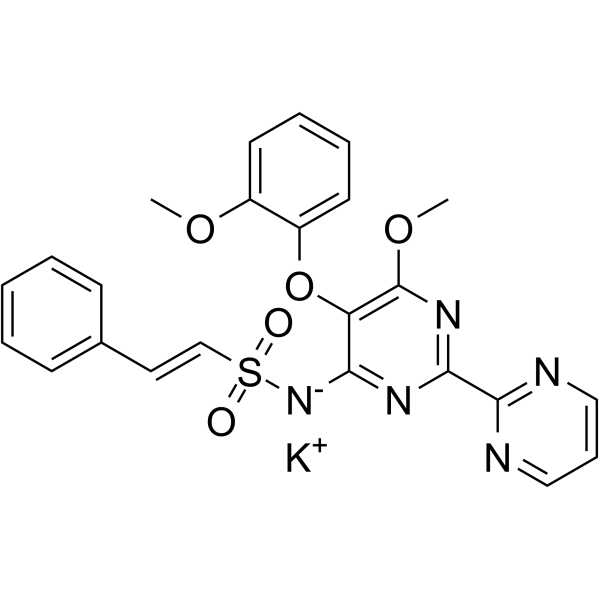
- HY-P2847
-
|
|
CRFR
|
Metabolic Disease
Endocrinology
|
|
Urocortin II, mouse is a potent and selective endogenous peptide agonist of type-2 corticotropin-releasing factor (CRF2) receptor with Ki values of 0.66 nM and ﹥100 nM for CRFR2 and CRFR1, respectively. Urocortin II, mouse activates CRF2 receptors in a cAMP/PKA- and Ca 2+/CaMKII-dependent manner.Urocortin II, mouse is expressed in discrete areas of the central nervous system, and activates central neurons involved in the processing of visceral sensory information, and in modulating autonomic outflow .
|
-
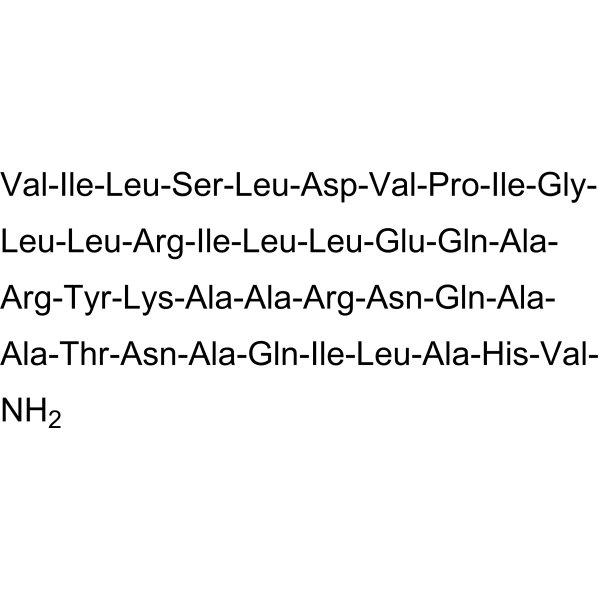
- HY-106844A
-
|
|
Others
|
Cardiovascular Disease
|
|
(+)-EMD 57033 is a cardiac troponin C (cTnC) activator, is a dominant Ca 2+ sensitizer. (+)-EMD 57033 binds the cardiac/slow skeletal troponin C isoform and exerts myocardial contractile promotion function .
|
-
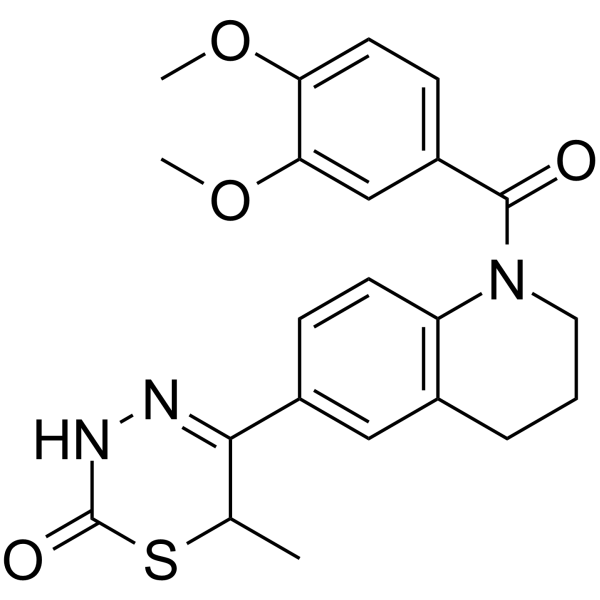
- HY-108594
-
|
|
Potassium Channel
|
Metabolic Disease
|
|
PD-118057 is a hERG channel activator without causing hERG blockade. PD-118057 activates hERG channel to suppress changes in membrane excitability .
|
-
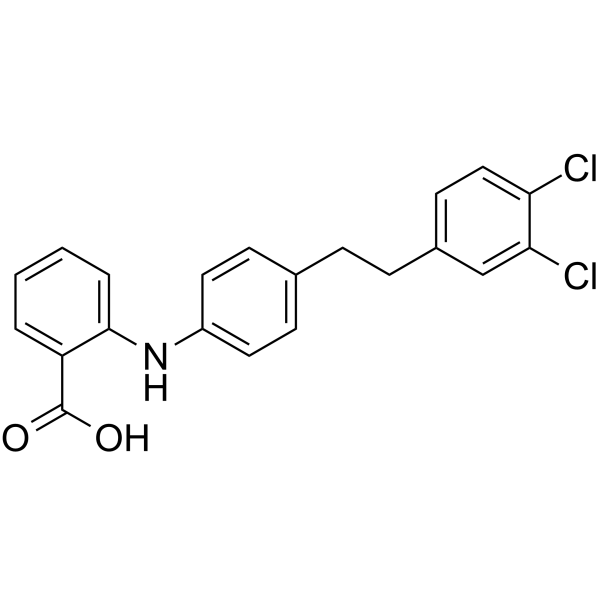
- HY-17412
-
-

- HY-17412A
-
-

| Cat. No. |
Product Name |
Type |
-
- HY-129763
-
|
|
Dyes
|
|
Di-4-ANEPPS is a voltage-sensitive dye in membrane potential. Di-4-ANEPPS allows reaching a time resolution better than 1 ms and exhibits changes in fluorescence of up to 10% per 100 mV. Di-4-ANEPPS is a common tool for mapping cardiac electrical activity. Di-4-ANEPPS demonstrate significant direct irreversible effect on spontaneous heart rate and ventricular impulse conduction in rabbit isolated heart model .
|
-
- HY-B0185G
-
|
Lignocaine (GMP)
|
Fluorescent Dye
|
|
Lidocaine (GMP) is Lidocaine (HY-B0185) produced by using GMP guidelines. GMP small molecules work appropriately as an auxiliary reagent for cell therapy manufacture. Lidocaine inhibits sodium channels involving complex voltage and using dependence . Lidocaine decreases growth, migration and invasion of gastric carcinoma cells via up-regulating miR-145 expression and further inactivation of MEK/ERK and NF-κB signaling pathways. Lidocaine is an amide derivative and has potential for the research of ventricular arrhythmia .
|
| Cat. No. |
Product Name |
Type |
-
- HY-W145695
-
|
|
Biochemical Assay Reagents
|
|
Chitoheptaose is a chitosan oligosaccharide. Chitoheptaose is capable of extracting exoskeletons from crustaceans, such as the shells of crabs, shrimp and lobsters. Chitoheptaose has antioxidant, anti-inflammatory and anti-apoptotic activities and can be used in the study of myocarditis. Chitoheptaose has cardioprotective effects and improves cardiac parameters (left ventricular internal size, end-systolic and end-diastolic, ejection fraction and shortening fraction), inflammatory cytokines (IL-1β) in vanishing models .
|
-
- HY-B0185G
-
|
Lignocaine (GMP)
|
Biochemical Assay Reagents
|
|
Lidocaine (GMP) is Lidocaine (HY-B0185) produced by using GMP guidelines. GMP small molecules work appropriately as an auxiliary reagent for cell therapy manufacture. Lidocaine inhibits sodium channels involving complex voltage and using dependence . Lidocaine decreases growth, migration and invasion of gastric carcinoma cells via up-regulating miR-145 expression and further inactivation of MEK/ERK and NF-κB signaling pathways. Lidocaine is an amide derivative and has potential for the research of ventricular arrhythmia .
|
| Cat. No. |
Product Name |
Target |
Research Area |
-
- HY-P0084
-
|
SRIF-14; Somatostatin-14
|
Peptides
|
Cardiovascular Disease
Neurological Disease
|
|
Cyclic somatostatin (SRIF-14) is a growth hormone-release inhibiting factor used in the research of severe, acute hemorrhages of gastroduodenal ulcers. Cyclic somatostatin is a neuropeptide co-stored with acetylcholine in the cardiac parasympathetic innervation, exerts influences directly on contraction of ventricular cardiomyocytes. Cyclic somatostatin inhibits the contractile response of isoprenaline with an IC50 value of 13 nM. Cyclic somatostatin can be used for the research of cardiovascular disease .
|
-
- HY-P3678
-
|
|
Neuropeptide Y Receptor
|
Cardiovascular Disease
Neurological Disease
|
|
Neuropeptide Y (18-36) (porcine) is a competitive neuropeptide Y (NPY) cardiac receptor antagonist. Neuropeptide Y (18-36) (porcine) inhibits the binding of I-NPY to cardiac ventricular membranes in a concentration-dependent manner with an IC50 value of 158 nM and an Ki value of 140 nM. Neuropeptide Y (18-36) (porcine) can be used for the research of congestive heart failure .
|
-
- HY-P5157
-
|
|
Potassium Channel
|
Neurological Disease
|
|
BmP02 is a selective Kv1.3 channel blocker and a highly-selective Kv4.2 modulator, which can be isolated from Chinese scorpion (Buthus martensi Karsch) venom. BmP02 also delays the inactivation of Kv4.2 in HEK293T cells, with an EC50 value of ~850 nM. BmP02 inhibits the transient outward potassium currents (Ito) in ventricular muscle cells .
|
-
- HY-P5494
-
|
|
Peptides
|
Others
|
|
DPc10 is a biological active peptide. (This is amino acids 2460 to 2495 fragment of cardiac ryanodine receptor (RyR2). RyR2 controls calcium release from the sarcoplasmic reticulum, which begins muscle contraction. Mutated RyR2 is associated to ventricular tachycardia (VT) and sudden death.)
|
-
- HY-P4911
-
|
|
CXCR
|
Cardiovascular Disease
|
|
SDF-1α (human) is a mononuclear cells chemoattractant that can bind to CXCR4. SDF-1α plays a central role in stem cell homing, retention, survival, proliferation, cardiomyocyte repair, angiogenesis and ventricular remodelling following myocardial infarction. SDF-1α (human) can be used in cardiovascular disease research .
|
-
- HY-P5904
-
|
Caveolin-1 scaffolding domain peptide
|
c-Met/HGFR
|
Others
|
|
Caveolin-1 (82-101) amide (human, mouse, rat) (Caveolin-1 scaffolding domain peptide) is a peptide that reverses aging-associated deleterious changes in multiple organs. Caveolin-1 (82-101) amide (human, mouse, rat) inhibits tyrosine kinases .
|
-
- HY-P2847
-
|
|
CRFR
|
Metabolic Disease
Endocrinology
|
|
Urocortin II, mouse is a potent and selective endogenous peptide agonist of type-2 corticotropin-releasing factor (CRF2) receptor with Ki values of 0.66 nM and ﹥100 nM for CRFR2 and CRFR1, respectively. Urocortin II, mouse activates CRF2 receptors in a cAMP/PKA- and Ca 2+/CaMKII-dependent manner.Urocortin II, mouse is expressed in discrete areas of the central nervous system, and activates central neurons involved in the processing of visceral sensory information, and in modulating autonomic outflow .
|
| Cat. No. |
Product Name |
Target |
Research Area |
| Cat. No. |
Product Name |
Category |
Target |
Chemical Structure |
| Cat. No. |
Product Name |
Chemical Structure |
-
- HY-129029S
-
|
|
|
Bisoprolol-d5 is the deuterium labeled Bisoprolol. Bisoprolol is a potent, selective and orally active β1-adrenergic receptor blocker. Bisoprolol has little activity on β2-receptor and has the potential for hypertension, coronary artery disease and stable ventricular dysfunction research[1][2].
|
-

-
- HY-B0432AS2
-
|
|
|
Propafenone-d5 (hydrochloride) is the deuterium labeled Propafenone hydrochloride. Propafenone (SA-79) hydrochloride is a class of anti-arrhythmic medication, which treats illnesses associated with rapid heart beats such as atrial and ventricular arrhythmias[1].
|
-

-
- HY-B0432AS4
-
|
|
|
Propafenone-(phenyl-dd5) (hydrochloride) is the deuterium labeled Propafenone hydrochloride[1]. Propafenone hydrochloride is a class of anti-arrhythmic medication, which treats illnesses associated with rapid heart beats such as atrial and ventricular arrhythmias[2].
|
-

-
- HY-B0432AS3
-
|
|
|
Propafenone-d5 Ethyl (hydrochloride) is the deuterium labeled Propafenone hydrochloride. Propafenone (SA-79)hydrochloride is a class of anti-arrhythmic medication, which treats illnesses associated with rapid heart beats such as atrial and ventricular arrhythmias[1].
|
-

-
- HY-B0259S
-
|
|
|
(rac)-Indapamide-d3 is a labelled racemic Indapamide. Indapamide is an orally active sulphonamide diuretic agent, that can reduce blood pressure by decreasing vascular reactivity and peripheral vascular resistance. Indapamide is also can reduce left ventricular hypertrophy[1][4].
|
-

-
- HY-B0185AS
-
|
|
|
Lidocaine-d10 (hydrochloride) is the deuterium labeled Lidocaine hydrochloride. Lidocaine hydrochloride (Lignocaine hydrochloride) inhibits sodium channels involving complex voltage and using dependence[1]. Lidocaine hydrochloride decreases growth, migration and invasion of gastric carcinoma cells via up-regulating miR-145 expression and further inactivation of MEK/ERK and NF-κB signaling pathways. Lidocaine hydrochloride, an amide derivative, has the potential for the research of the ventricular arrhythmia[2].
|
-

-
- HY-14188S
-
|
|
|
Amiodarone-d4 (hydrochloride) is the deuterium labeled Amiodarone hydrochloride. Amiodarone hydrochloride, a benzofuran-based Class III antiarrhythmic agent, inhibits WT outwardIhERG tails with an IC50 of ∼45 nM[1]. Amiodarone hydrochloride induces cell proliferation and myofibroblast differentiation via ERK1/2 and p38 MAPK signaling in fibroblasts[2]. Amiodarone hydrochloride can be used in the research of both supraventricular and ventricular arrhythmias[1].
|
-

-
- HY-B0185S1
-
|
|
|
Lidocaine-d10 is the deuterium labeled Lidocaine. Lidocaine (Lignocaine) inhibits sodium channels involving complex voltage and using dependence[1]. Lidocaine decreases growth, migration and invasion of gastric carcinoma cells via up-regulating miR-145 expression and further inactivation of MEK/ERK and NF-κB signaling pathways. Lidocaine is an amide derivative and has potential for the research of ventricular arrhythmia[2].
|
-

-
- HY-B0185S
-
|
|
|
N-Oxide Lidocaine-d10 is the deuterium labeled Lidocaine. Lidocaine (Lignocaine) inhibits sodium channels involving complex voltage and using dependence[1]. Lidocaine decreases growth, migration and invasion of gastric carcinoma cells via up-regulating miR-145 expression and further inactivation of MEK/ERK and NF-κB signaling pathways. Lidocaine is an amide derivative and has potential for the research of ventricular arrhythmia[2].
|
-

-
- HY-B0185AS1
-
|
|
|
Lidocaine-d6 (hydrochloride) is deuterium labeled Lidocaine (hydrochloride). Lidocaine hydrochloride (Lignocaine hydrochloride) inhibits sodium channels involving complex voltage and using dependence[1]. Lidocaine hydrochloride decreases growth, migration and invasion of gastric carcinoma cells via up-regulating miR-145 expression and further inactivation of MEK/ERK and NF-κB signaling pathways. Lidocaine hydrochloride is an amide derivative and a agent to treat ventricular arrhythmia and an effective tumor-inhibitor[2].
|
-

| Cat. No. |
Product Name |
Application |
Reactivity |
-
- HY-P82964
-
|
Myosin regulatory light chain 2; ventricular/cardiac muscle isoform; MLC-2; MLC-2v
|
WB, IHC-P, IP
|
Human, Mouse, Rat |
Your information is safe with us. * Required Fields.
Inquiry Information
- Product Name:
- Cat. No.:
- Quantity:
- MCE Japan Authorized Agent:


























































































